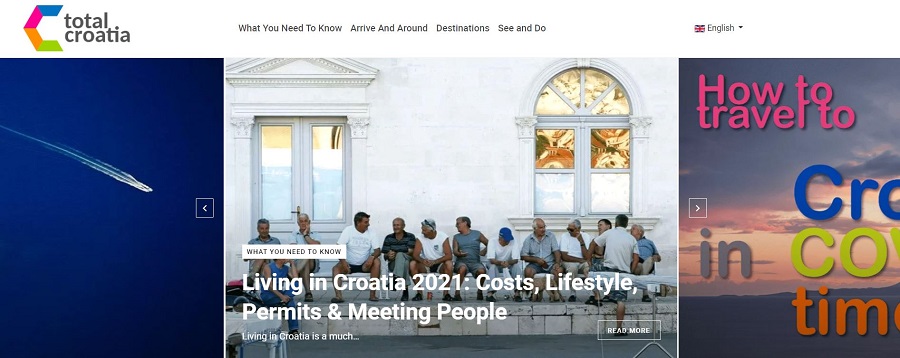Five Places You Must Visit During Spring in Croatia
March 10, 2022 - This month, the frigid temperatures and strong winds of winter have already begun to turn into warm and colorful days, thus welcoming spring. Is it worth visiting during this time of year? Of course. And here are five places you cannot miss during spring in Croatia.
Winter in Croatia is a difficult concept to criticize. Despite low temperatures, strong winds, snow, or rain, Croatians have always found a way to positively view the arrival of the winter months. In central and eastern Croatia, the cold and snow are not strong enough to break the spirit of its inhabitants. Winter is synonymous with the holiday season, with cities and towns brightly and colorfully decorating their streets, and filling their parks and plazas with fairs and concerts.
In the same way, along the Croatian coast, the locals take back the cities from the tourists and the storms are intermittent since sunny days predominate. Thus, the people who live in front of the Adriatic find a great excuse to put on their best coats, their sunglasses, and get together with their friends and family to have a coffee in the rivas and old towns of their cities.
However, it is true that when the day darkens at five in the afternoon or the temperature of the sea is too cold to take a dip, summer days are missed throughout the country. For this reason, the arrival of spring is always welcome in Croatia and invites those who reside in the country to venture outside their homes without having to wear more than two pieces of clothing. The beginning of spring in Croatia is March 20, and so that you can plan your next adventure, we share five places that you cannot miss at this time of year.
Zagreb
Perhaps the first thing that comes to mind when thinking of spring in Croatia is some of its 8 national parks or 12 nature parks. However, the Croatian capital of Zagreb is literally a spectacle of colors and a great atmosphere during this time of year. Although the official date for the beginning of spring is still 10 days away, the inhabitants of Zagreb are already witnessing the first blooms in their avenues, streets, and parks. If you're coming to Zagreb during spring, you probably won't know where to start.

Flowers blossoming in the gardens of King Tomislav Square. (Photo: Patrik Macek/PIXSELL)
Stroll through the beautiful parks in Zagreb's upper town, from Zrinjevac to King Tomislav Square, where you could even sit in its gardens reading a book while enjoying the atmosphere and the colors of its flowers and trees. If you want to go for exercise and at the same time enjoy the blossoming in the spring, visit the parks of Jarun, Bundek or Maksimir, in which you could also organize a picnic with your friends. Or maybe organize a walk through the Zagreb Botanical Garden, in the upper town of Zagreb. You will see that when you get home and check your phone, you will have probably taken more than a hundred photos throughout the day. Zagreb is home to many of the best spots to be during spring in Croatia.
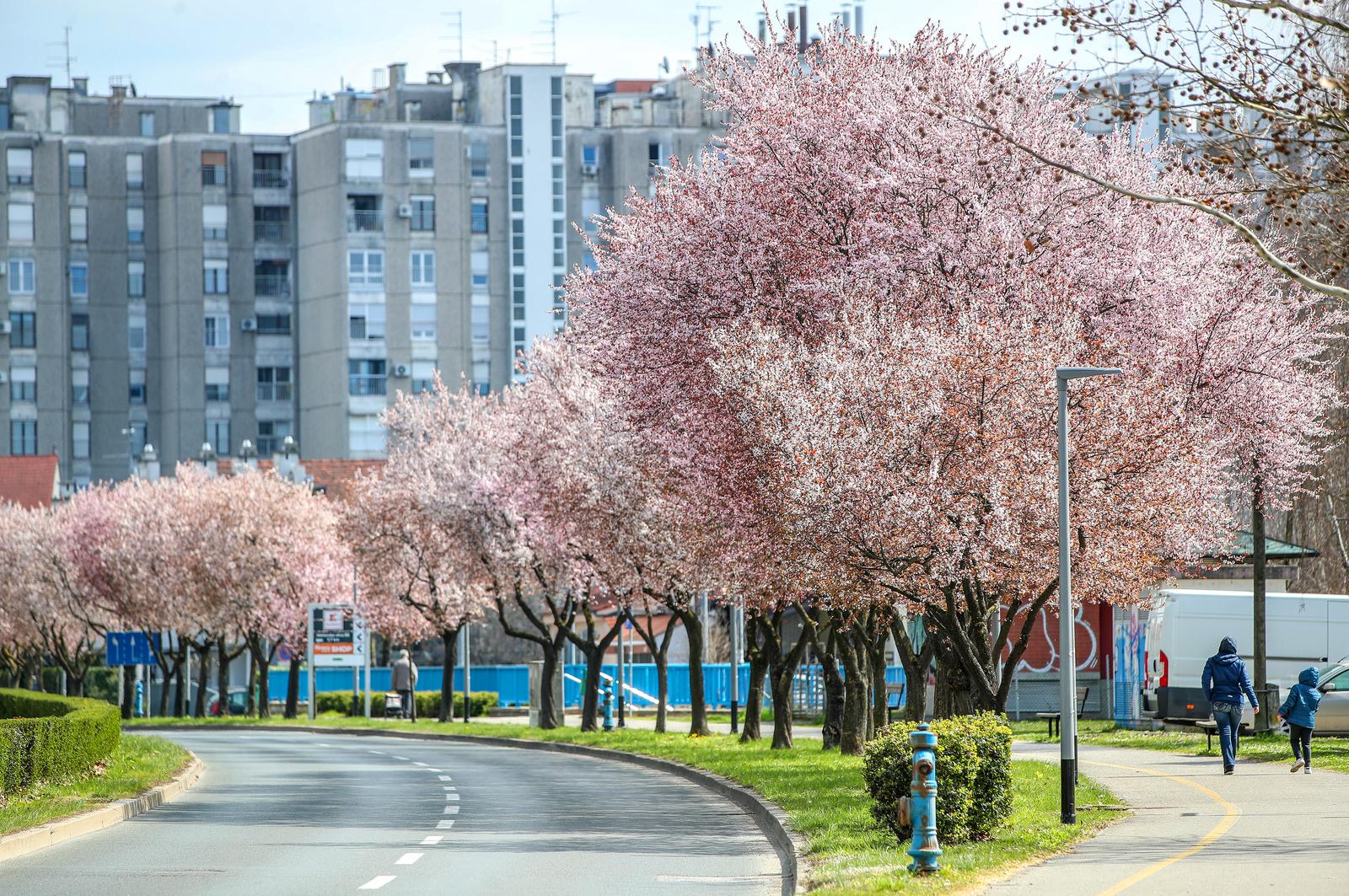
Cherry trees in the district of Prečko, Zagreb. (Photo: Igor Kralj/PIXSELL)
Bonus tip: visit Šulekova street in Zagreb in Spring, which has become famous for its spectacular colors thanks to the blossoming of its cherry trees. Don't forget to go with someone who can take amazing pictures of you for your Instagram!
Plitvice Lakes National Park
It really is impossible not to highlight the national and natural parks of Croatia when talking about a change of season. I do not mention a season in particular because each one offers something magical and different. For example, when we talk about Plitvice Lakes National Park, we cannot compare the four seasons, just enjoy them to the fullest. Autumn's intense red and orange colors beautifully contrast with turquoise lakes, resembling a frame straight out from a fairy tale. Winter covers the park with snow, and the result is a mixture of whites and turquoises that will make your jaw drop. And not to mention the summer, where the green forests also serve as a refuge from the high temperatures with their shade.
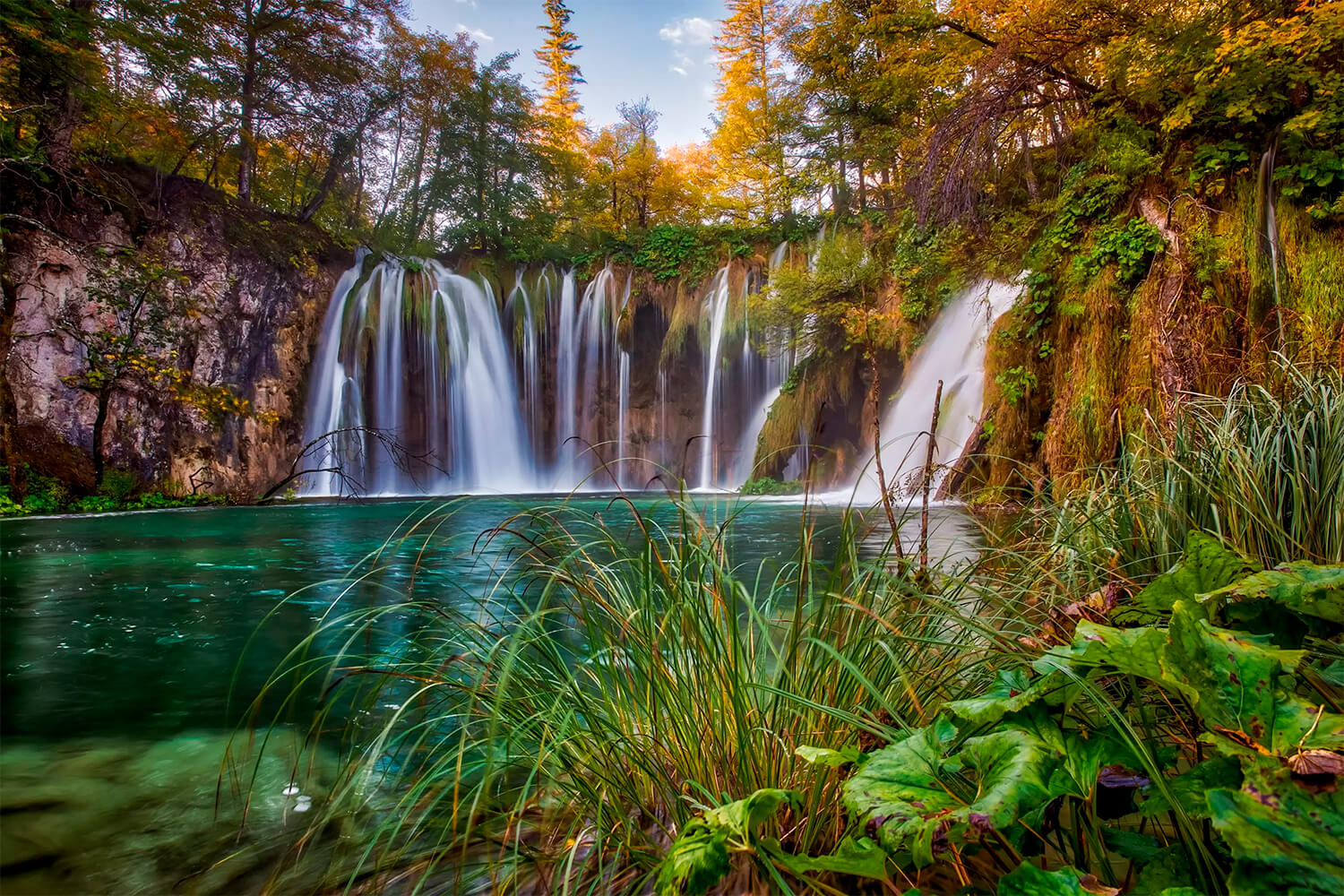
Plitvice Lakes National Park, stunning all year round. (Photo: Vedran Bozičević)
But we all know that, in a place as diverse in flora as the Plitvice Lakes National Park, it is essential to witness its colorful show during spring. It's arguably the perfect time, as it's neither too cold nor too hot to overwhelm you as you wander through the park, and it's one of its most photogenic times of the year!
Find HERE the prices and rates of the tickets to visit the Plitvice Lakes National Park.
Split
We also don't want to overwhelm you with a shower of colors, if that's not your thing. And it is not because Split does not have them, but the experience of spring in the Dalmatian city is lived in a different way. Spring in Croatia comes in different shapes and colors. Although the trees and parks of Split are also beginning to regain their leaves and greenery, the arrival of spring means that the return to the sea and the beaches is getting closer. You will feel that wearing a coat could be unnecessary, with temperatures that can rise up to 17 degrees. Even with the water still relatively cold, some brave souls are already starting to visit the city's beaches to take a dip, realizing that the frequent sunny days and rising temperatures will dry them out quickly once out of the water.
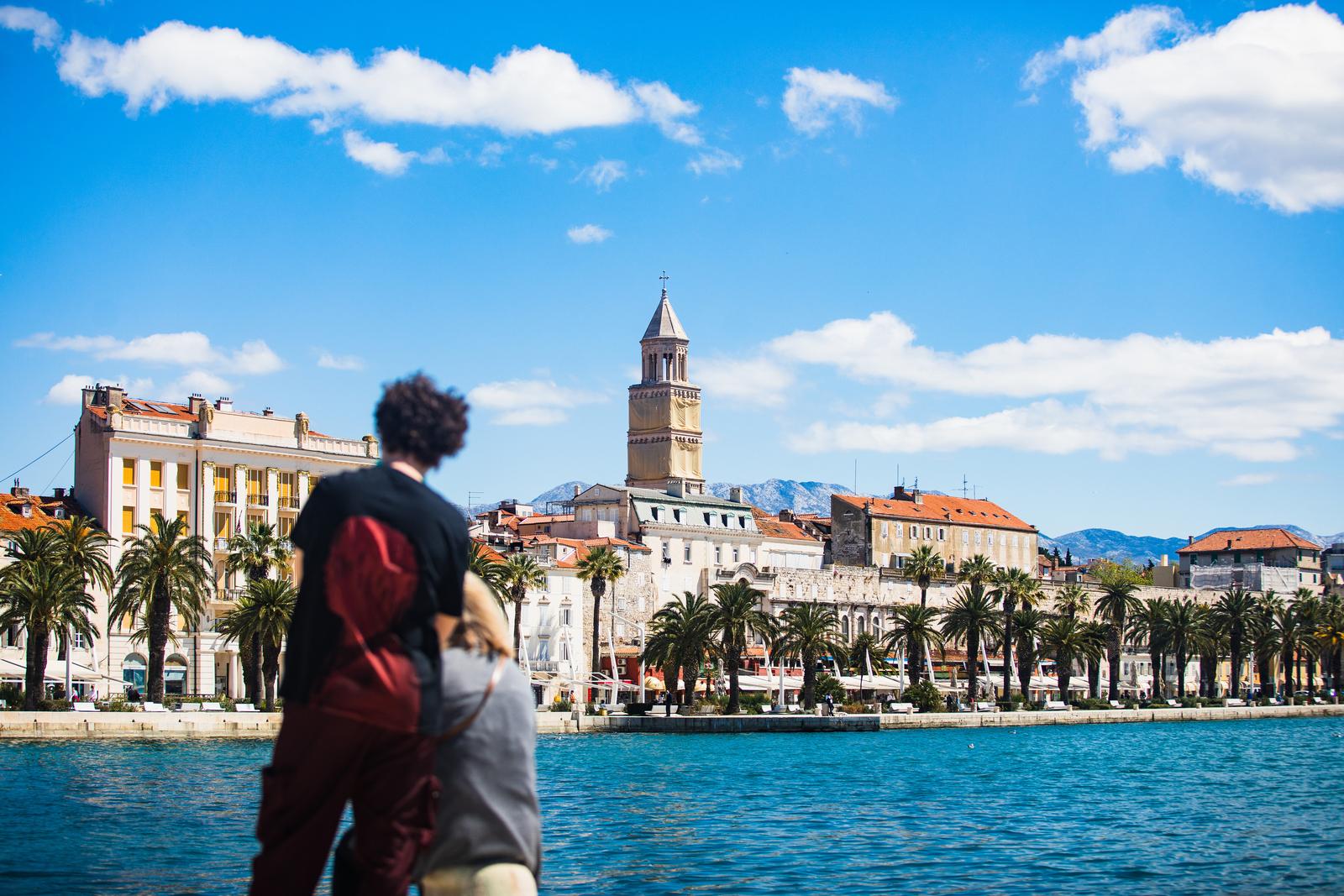
The Diocletian Palace in Split, not during summer, but in April. (Photo: Milan Sabic/PIXSELL)
But without a doubt, the most exciting thing about spring in Split is the progressive reopening of many restaurants, bars, and cafes throughout the season, which have already finished their respective maintenance and are beginning to prepare for the arrival of the busy summer. If you were in Split during the winter, and you will stay here until at least the beginning of summer, you will witness a city that is becoming active every day. Also, ferry lines are starting to increase and you can have the privilege of visiting more islands and destinations without the crowds. And beware, enjoying spring in Split is something that can be replicated throughout the Croatian coast, from Istria to Dubrovnik!
Krka National Park
If you change your mind and would indeed like to see the spring in Croatia blooming at its best, there will always be a national park or nature park near you. The Krka National Park has nothing to envy Plitvice Lakes since its sixteen plunging waterfalls, winding hiking trails, and vast expanse of lush, green forests place it as one of the most visited destinations in the entire country. Krka, apart from being recognized for its spectacular sceneries, is also a very popular destination for adventure lovers. Whether on foot or by bicycle, it is never enough to discover all the wonders that the national park hides. And if you had to pick an ideal time of year to visit, the spring months should be at the top of your list.
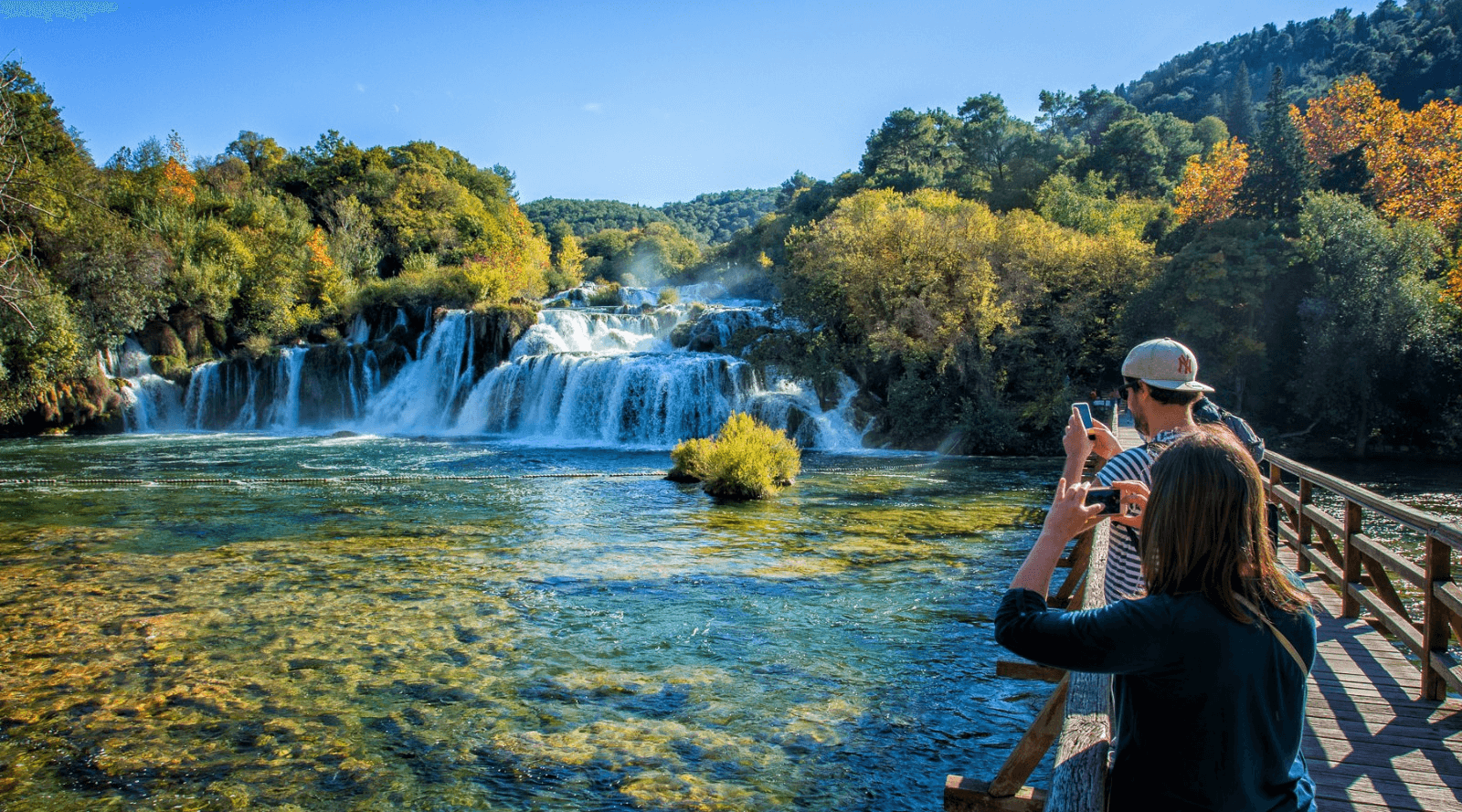
Very close to Šibenik, and less than an hour from Split - Krka National Park. (Credit: Krka National Park)
Although the new measures taken by the National Park, which prohibit visitors from bathing in the falls, have reduced the saturation of people in the main circuit of Krka, summer is still the time of year with the highest volume of tourists. If you are looking to connect better with the nature of Krka, you will surely find it in spring with almost as pleasant weather, colors everywhere, fewer people, and... cheaper prices!
Find HERE the prices and rates of the tickets to visit the Krka National Park.
Osijek
Of course, spring comes everywhere, and not only on the coast and in central Croatia. Moreover, it could be said that spring in eastern Croatia arrives with incomparable intensity. The vast forests, fields, and crops in Slavonia and Baranja are a visual delight both for those viewing it from above with their drones, as well as for those on foot. This part of Croatia is often mistakenly considered a cold, nothing-happening region, but few have the privilege of enjoying its energy and warmth all year round, even in the harshest of winters. And all the more reason, you'll want to check it out for yourself in a season with better weather and full of greenery.
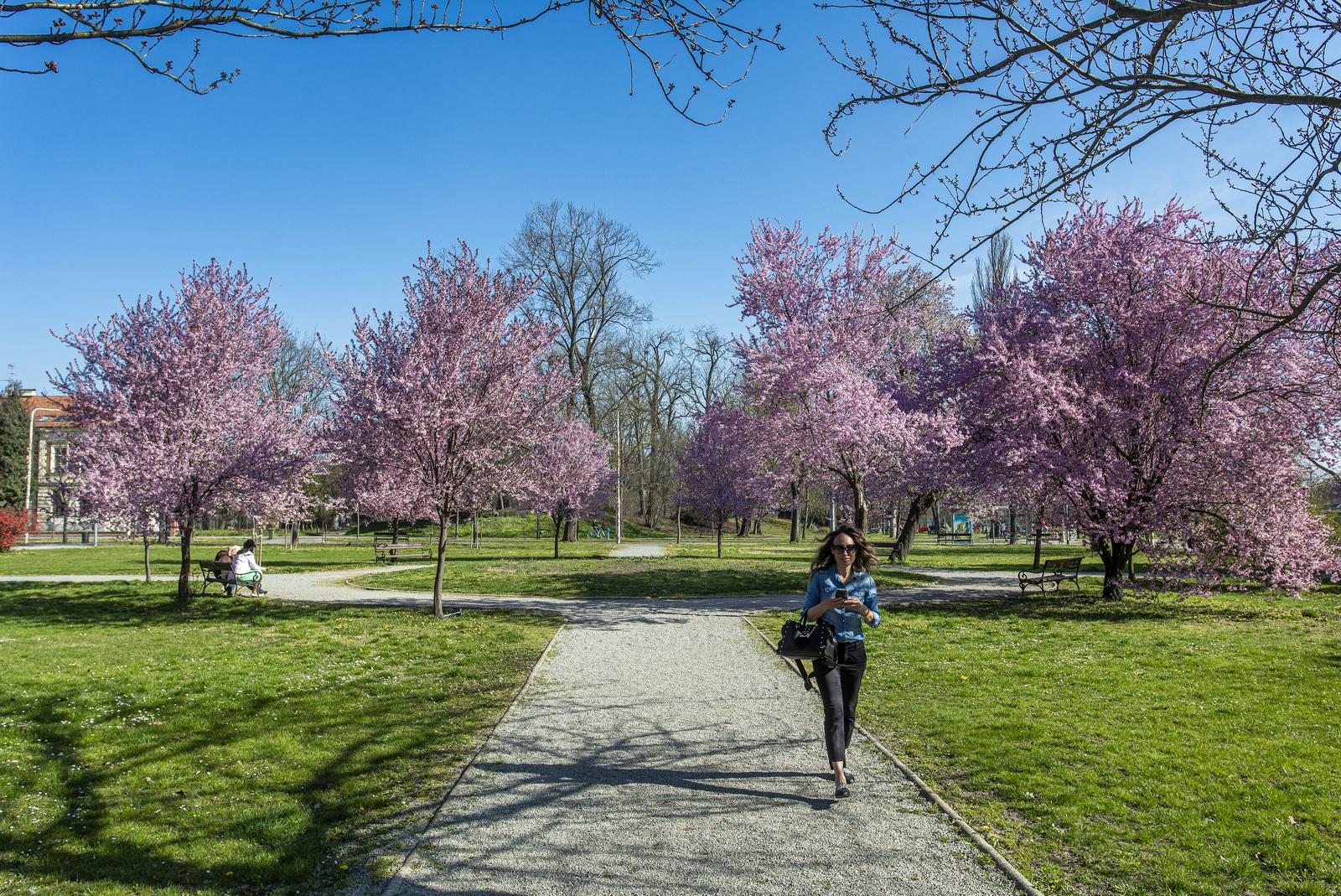
Cherry trees in King Krešimir IV park in Osijek. (Photo: Davor Javorovic/PIXSELL)
There are so many places to visit in this region during spring, but what better place to start than in the largest city in eastern Croatia, and the fourth largest in the country. Osijek is famously known as the greenest city in Croatia, with more parks and public green areas than any other town in Croatia. Wherever you go in Osijek during the spring, you will come across an immeasurable number of trees and gardens full of vibrant colors. Some of the parks that you cannot miss are King Tomislav Park, Sakuntala Park, or King Krešimir IV Park, protected as the first monument of park architecture in Croatia.

Cherry trees in King Krešimir IV park in Osijek. (Photo: Dubravka Petric/PIXSELL)
These are just five examples of places that you cannot miss during spring in Croatia, but believe us when we tell you that the whole country, throughout its territory, has some magic waiting for you during the most colorful season of the year.
For more on travel in Croatia, follow TCN's dedicated page.
"Ash Wednesday" Begins Lent: Food Eaten in Time of Penance in Slavonia
March 2, 2022 - Wednesdays normally do not have a particular meaning but for Catholics, today means the start of Lent, which is a time for mourning, renunciation, and penance. Food is light, “sacrifices” are made, and forty days until Easter has begun. A look into what Slavonians eat during Lent.
If February in Croatia is known as a month of handful feast food, the month of this year’s March represents “sacrifices” Catholics are willing to take to “cleanse” themselves before Easter and the resurrection of Jesus Christ. Those sacrifices usually involve food - no meat, sweet desserts, and other types of food we love the most. Today's Clean Wednesday or “Ash Wednesday” marks the so-called commanded fast, which means strict fast requirements as a symbol of Jesus’s sacrifice during time spent in the desert before his eventual resurrection (Easter). Its name “Ash Wednesday”, comes from the rite of cremation, when priests sprinkle ash on the heads of the faithful or, according to the customs of the region, make the sign of the cross on their foreheads with ash. Sprinkled ash used on these rites is last year’s olive twigs blessed on the Palm Sunday (Cvjetnica) - a feast that commemorates Jesus’ entry into Jerusalem.
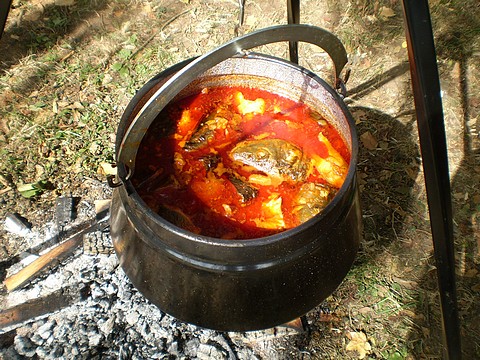
"Fiš" - traditional Slavonian food. (Najbolje u Hrvatskoj by vikendplaner.info)
But enough of that, let’s get to the most important point of this article. Food. Because of everything mentioned, people needed to find ways to eat food that would match the requirements Lent demands. Of course, the diet of the people differed both because of preferences and differences of working classes. The most popular Lent dish is definitely Fish stew (Fiš-paprikaš or in Slavonia just Fiš). No holiday of this kind in Croatia can pass without fish stew. It is so popular and an integral part of the Slavonian culture that competitions are regularly held throughout Eastern Croatia (Fišijada), for the title of the best "fiš” makers in the region. As its name suggests, the fish stew is prepared from fish, especially river fish which means it is common in regions where rivers are of great importance. It is believed that it was brought to the Slavonian area by immigrants from southern Germany, whereas Baranja got their “fiš” from Hungarians that inhabited that area. Fish stew is traditionally prepared in a copper cauldron hung over an open fire. Water is put into the cauldron with sliced pieces of river fish such as catfish, carp, pike or perch, and (a lot of) onion, and everything is boiled together on the fire. Just before the fish is cooked, spices are added to the water to give stew its characteristic color and spiciness. It is, of course, ground sweet and hot paprika which is often used in Slavonia and Baranja. The “fiš” is usually cooked for twenty more minutes with the addition of other ingredients like salt, tomato sauce, and more and in the end, it is served with homemade noodles and special homemade bread.
Nevertheless, every Slavonian family has its own recipe so it's hard to pinpoint a perfect one, however, it brings even more charm and beauty to this traditional dish. Families with less usually cook “fiš” with only one type of fish, mostly carp and catfish.
River fish is also really healthy, especially if it's cooked in the oven. It retains the maximum of useful components in the form of vitamins and minerals. Most importantly, the dish is simple enough and does not require inaccessible ingredients. It is usually served with potato salad which can vary, of course, depending on the household. Fried fish is also viable during Lent but strong believers are avoiding it for scarcer meals.
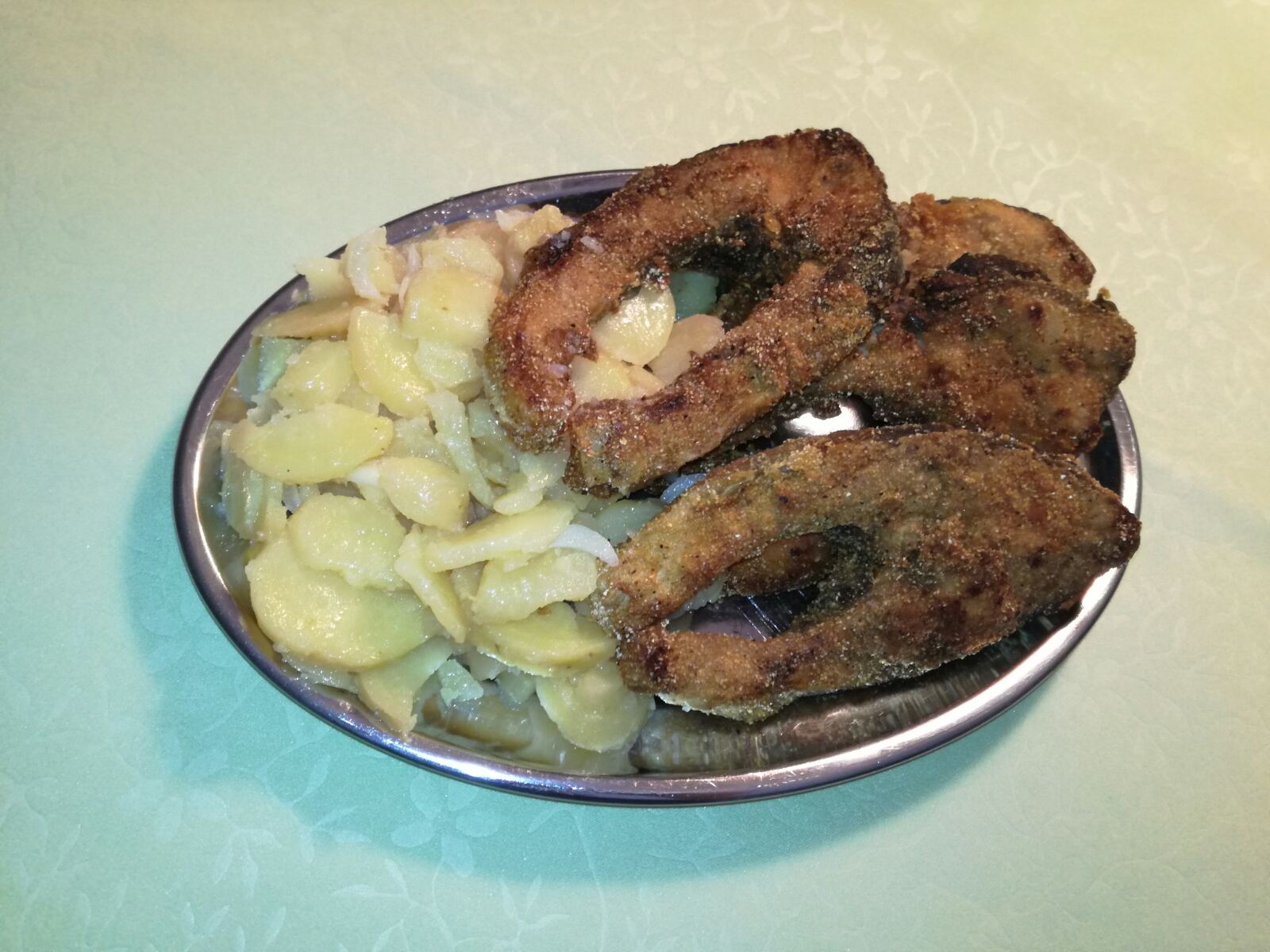
My aunt's fried carp with potato salad. (Private album/Dora Naletilić)
Homemade noodles are a close second in “popular Lent dishes in Slavonia” category. They are more of a side dish these days, however, poorer families who didn’t always have access to fish had to find ways to feed themselves. Popular dishes with noodles in Slavonia are noodles with eggs, semolina ones that are sweet and fall into the category of scarcer meals. However, the ones with potatoes are probably the most popular ones, in Slavonia better known as “granatir”. Cheap ingredients like noodles, onions, potatoes, and more, fed generations of Slavonians who didn’t have the luxury of buying fish and other too expensive ingredients for them.
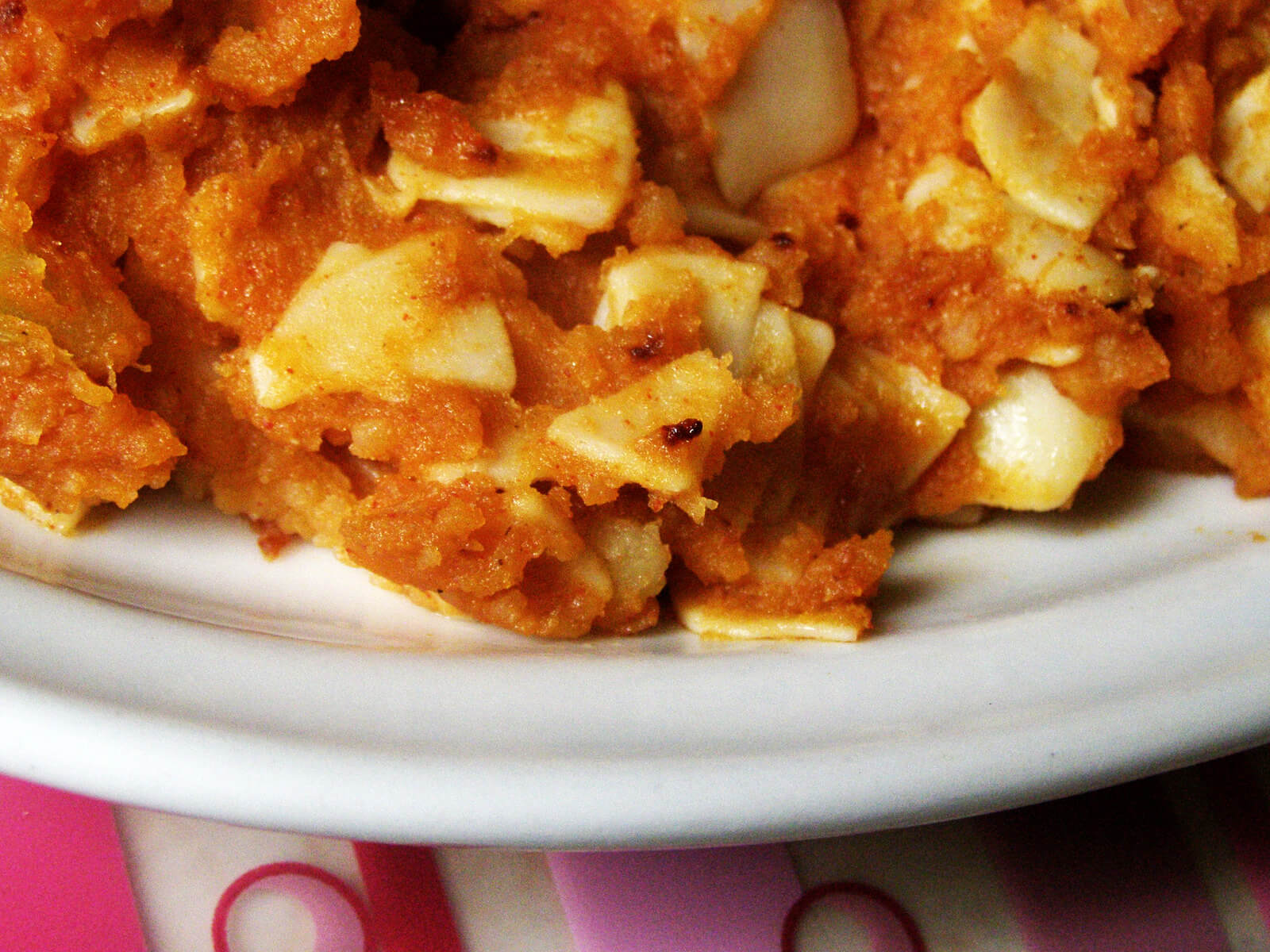
"Granatir" - noodles with potatoes. (Credit: Coolinarka)
Also, it is important to highlight that these dishes are made for one consummation a day so that people fasting during Lent experience penance.
As said at the beginning of the article, Lent has started and the time of “sacrifice” has begun. These times do not have the splendor of food, as usual, however, it only shows the resourcefulness of people during fasting and difficult times. Even though Slavonia is known for its heavy, meat-based food, these times, like Lent, show that this region is very versatile and can make a dish accessible to all. You don’t have to be a Catholic or even a believer to try these foods, just come and get into the spirit of Slavonia.
For more, check out our lifestyle section.
Carnival in Eastern Slavonia: February Masquerade Traditions (Part II) - The Food
February 23rd, 2022 - With every traditional festivity comes a reflection of our ancestors' lives, which ties closely to what they ate. This is part two of Carnival in Eastern Slavonia, but this time - the food edition. A look into what Slavonians eat during this traditional event.
Even though it was mentioned in the previous article that the roots of Carnival and Masquerade don’t have anything to do with Christianity and other religions, here in Eastern Slavonia, people decided to connect these traditions with Lent and Easter, which is usually a month and a half later in the Catholic calendar. Food is a significant identifier for every region in Croatia. For instance, Slavonia is popular for its heavy food: pork meat-based food like kulen, its “sister” seka, cracklings (čvarci), sausages, and stews made from beans, cabbage, and many more. Other homemade products are jams made from plums, quinces, apricots, and whatever fruits are available during the summer season. Furthermore, those jams are stored in cold pantries and can last for more than a year if it’s preserved and packed correctly. All mentioned dishes and products are consumed during winter until another set of preparations - always scheduled simultaneously and dated.
In February, these “heavy” dishes, especially dried meat ones like cracklings, are usually used for baked delicacies like čvarnjače, which are made so the leftover cracklings are not thrown away. They are made of salty leavened dough made out of fine flour with grounded cracklings (made out of melted lard) and can be eaten with sour cream or yogurt.
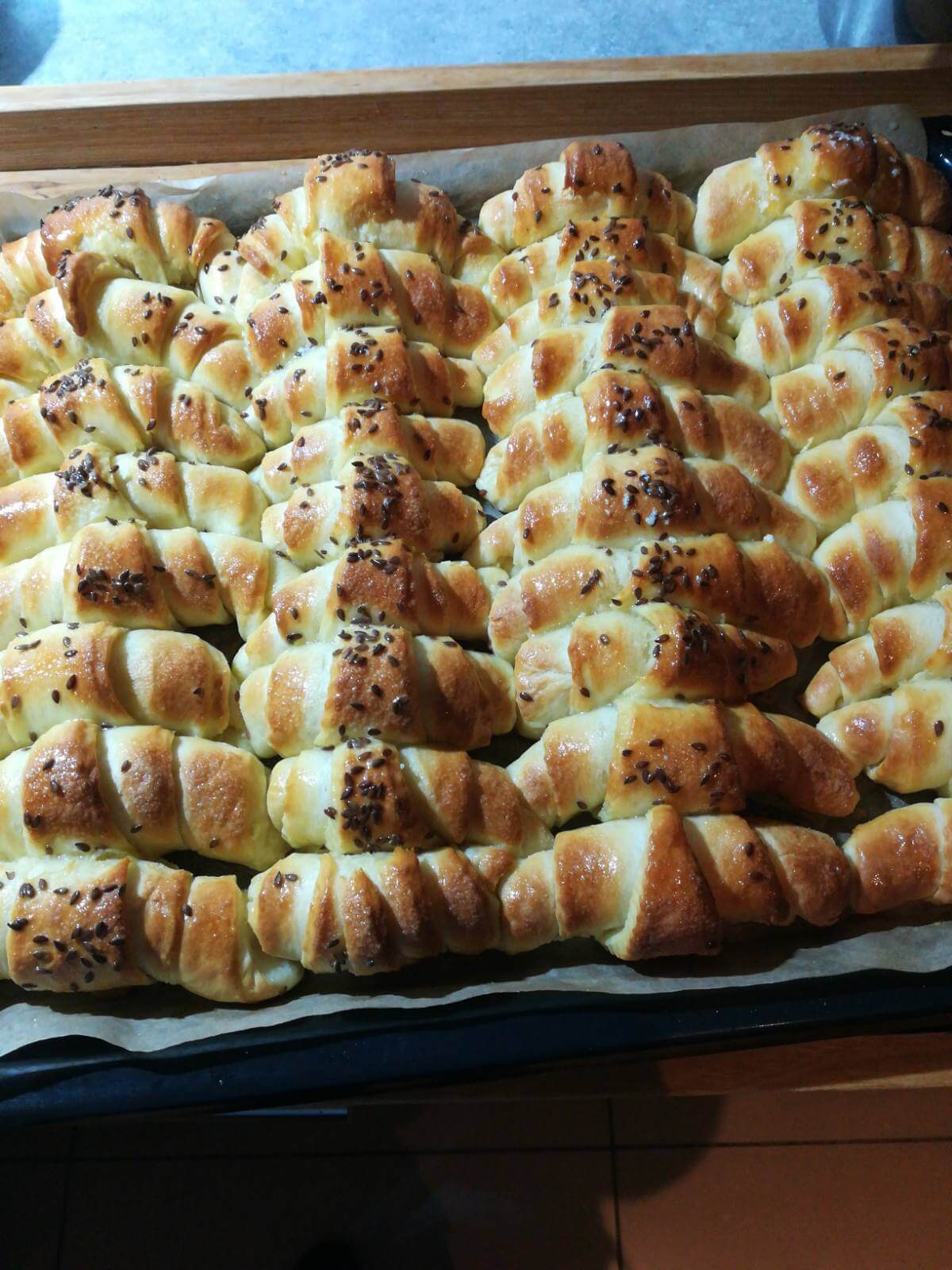
My aunts rolls - "kiflice," Private album
Rolls (kiflice) are also made from salty, leavened dough. Before putting them into the oven, they’re coated with eggs or milk for the colour and sprinkled with sesame or cumin. Since rolls are usually served empty as a snack, Slavonians eat them with a plate of dry meat like kulen, ham, and sausages. It can also be eaten with dairies. My personal favourite is when they are filled with ham and cheese.
Now we get to the good stuff. Sweet delicacies.
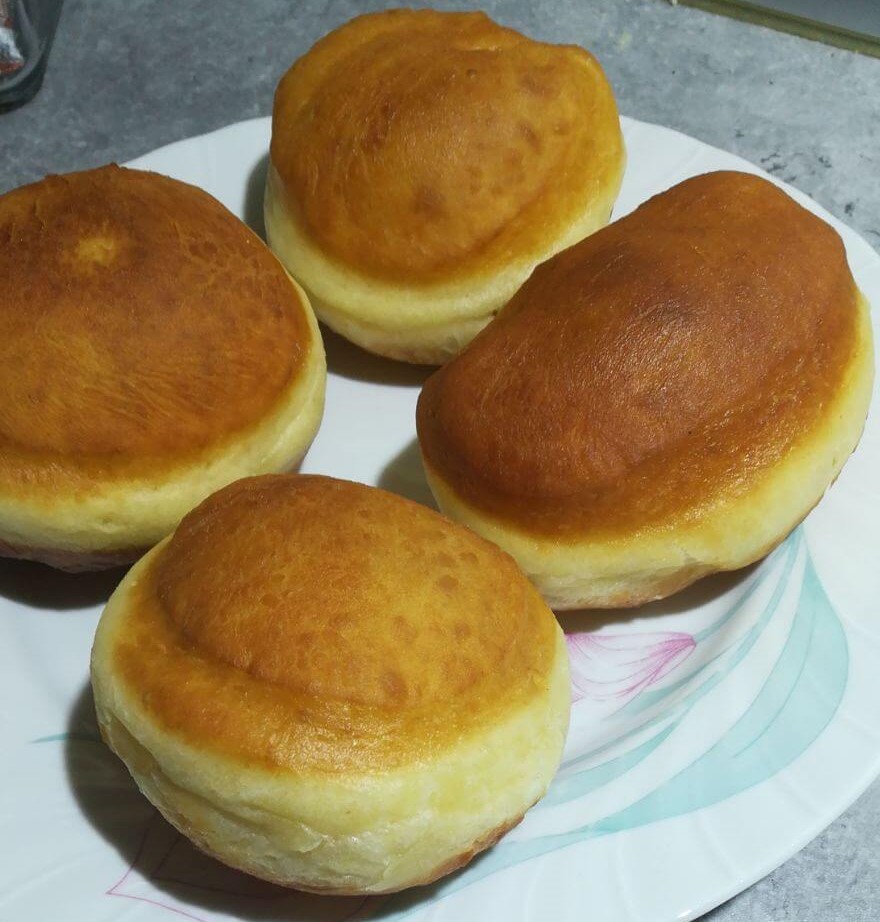
My aunts "krofne" , Private album
During carnival and masquerade in February, the most popular sweet food is donuts (krofne). It is a German sweet dessert made of leavened pastry, baked primarily in hot fat in these parts of the country or oil. In Slavonia, these donuts are called “krofne,” which is a distorted name from the German word “krapfen,” whereas in northern parts like Zagreb and the region of Zagorje, they’re called “krafne”. Interestingly, they’re not usually baked very often, only on special occasions, like “svinjokolja” (pig slaughter), New Year’s, and of course, Carnival. Furthermore, our ancestors believed that “krofne,” while being cooked and rising in volume, symbolizes grace in every aspect of life. Nevertheless, “krofne” are still very prominent in the lives of Slavonians, and they’re usually eaten with powdered sugar and homemade jams. Newer versions of “krofne” come with Nutella and other chocolate spreads, which are very popular with children.
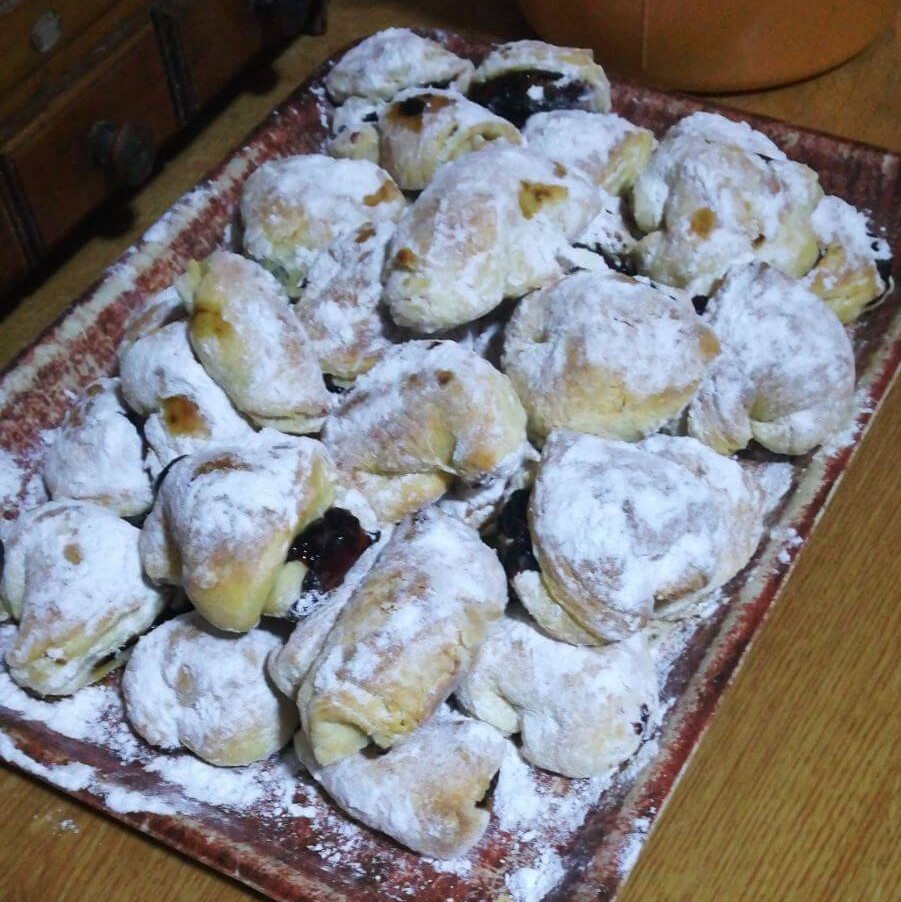
My aunts "salednjaci" - puff pastry dessert with homemade jam, traditional Slavonian delicacy, Private album
This sweet delicacy is a typical traditional Slavonian dessert prepared during “svinjokolja” and the Carnival - “salednjaci.” The name varies in other regions in Croatia; for example, in Zagreb and Zagorje, it is called “salenjaci.” Butter is a usual ingredient for puff pastry, but mothers and grandmothers would use pig lard because there would be a lot of it left after pig slaughter. Also, butter was costly back in the day, so people had to find ways to make those desserts. This delicacy is known as “Croatian croissants with character” and “a cake with thousand leaves” since the puff pastry is folded four times during the process. They’re usually filled with homemade blue plum or an apricot jam. Unfortunately, people have reservations about this dessert because of a misconception that pig fat or lard are not healthy.
On the contrary, it’s healthier than most of the ingredients we consume today. The dessert got lost in the last two decades or so, but it’s slowly coming back through the effort of institutions that preserve tradition and women who started bringing out this dessert on special occasions. Of course, that includes traditional events and festivities in Slavonia during wintertime.
Furthermore, sweet cakes and pastries like “mađarica,” “bijela pita,” “medena pita,” and more are also included on this list. Still, it would take a few more articles to name all traditional Slavonian food.
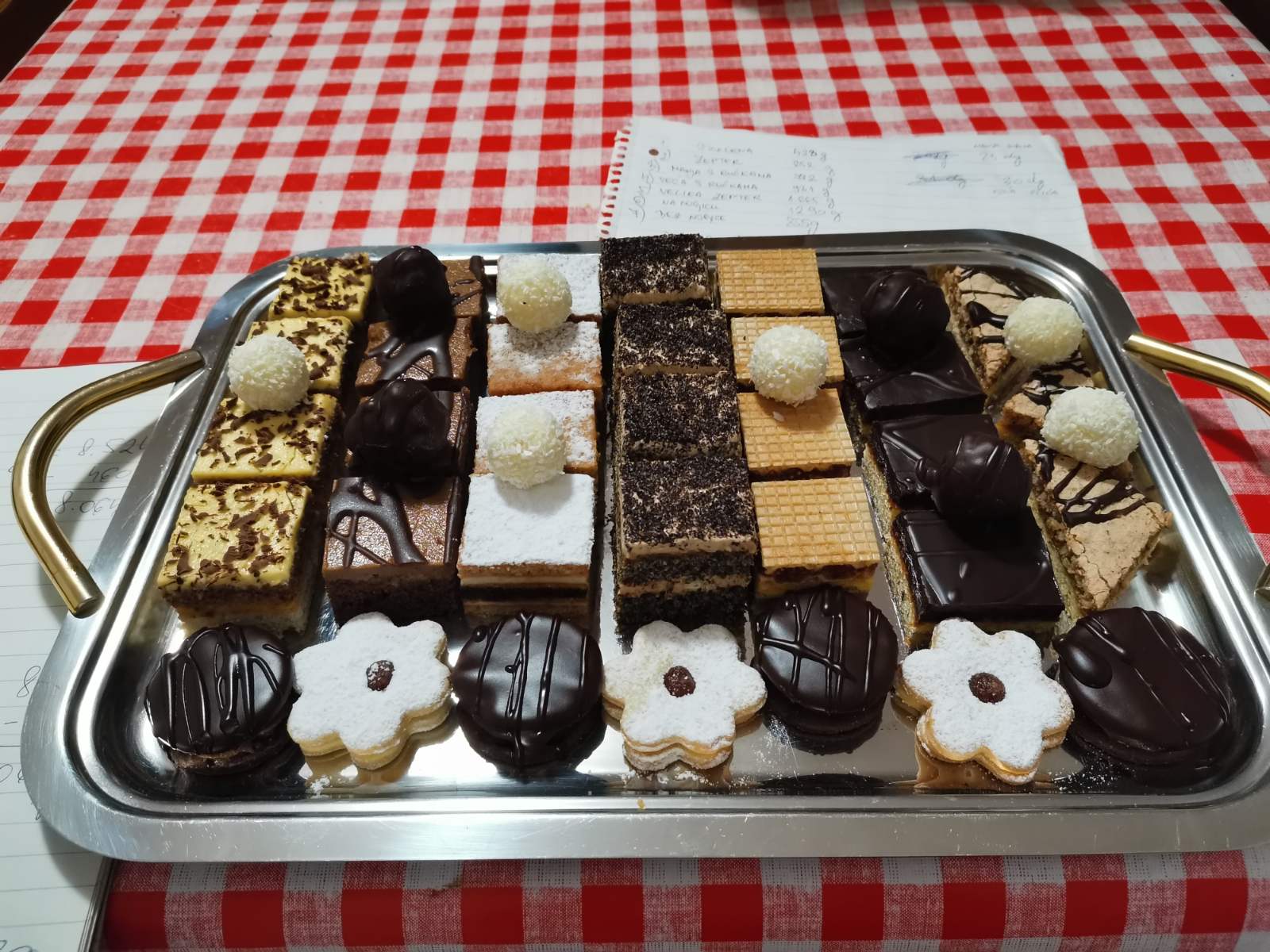
My mother's sweet cakes and pastries, usually made during winter times, Private album
In the end, this article can also be used as an invitation for you to come to Slavonia and participate in the Carnival and other festivities to try these rich delicacies that fed generations and generations of people and still do. There are seven days left until Lent, so hurry up and experience the rich Slavonian life because if there’s one thing Slavonians know how to do, it is eating rich and enjoying life.
For more, check out our lifestyle section.
Carnival in Eastern Slavonia: An Intro to February Masquerade Traditions (Part I)
February 16th, 2022 - In Croatia, after Christmas and New Year's, February is usually reserved for the Carnival, which is tightly connected with the Masquerade tradition that leads to the Carnival as an intro to Lent and later, to Easter. Each region has its own tradition that has been maintained for centuries. A look into Carnival in Eastern Slavonia.
The Carnival (Poklade) is a calendar custom between the Epiphany (January 6) and Lent (Korizma). It is marked by masked processions and parties, merriment, madness and debauchery, and an abundance of food and drink. The highlight of the event is the last Sunday, Monday, and Tuesday (Shrove Tuesday) before Ash Wednesday. Its roots don’t have anything related to Christianity - primarily of magical, apotropaic significance. Any disguise, clothes worn on the wrong side, deafening noise, pouring ashes, and more, should drive away the winter, demons, and evil forces that repel their actions from people, livestock, homes, and crops. Carnival events in the Croatian folklore tradition can be divided into two main types. One type is referred to as lupercal; they are seemingly more archaic, common in the rural and livestock areas. Participants are groups of men dressed in animal skins, with bells hung on their bodies or worn on their hands. The second type of carnival event in Croatia is saturnal; they occur in cities, particularly common on the Adriatic coast and island areas. These usually contain less magical features and are more focused on entertainment and social criticism. As mentioned before, even though the event overlaps with Christian holidays, the Catholic Church has been trying to suppress these traditions for centuries because of the opposing nature to every existing authority throughout history.

Photo credit: Marko Miličević - načelnik Općine Ivankovo
The Eastern Slavonian Carnival is used for the hedonistic type of “partying” before Lent - a time for mourning, renunciation, and penance. Every village has its own day for organizing the Carnival, it all depends on when Lent starts. Carnival time starts with Masquerade (Maškare), more precisely, the procession of rural masquerades with participants disguising themselves in various characters. Men are mostly dressed as women and women are dressed as men. Masked groups visit every house in the village and sing in front of them for gifts like sweets, food, and drinks. After that, “masqueraders” thank the hosts and continue their journey through the village looking for more gifts. However, in the 2000s, these masked groups became groups of children who would go on tour all over the village after school, singing and seeking gifts from villagers. If a host doesn’t react to the singing of masked children and doesn’t come out of the house, houses get “attacked” by rotten eggs. This tradition probably came into relevancy in the last 20 years or so because it is impossible to find a legit source about it and it is not a really pleasant experience, especially if you need to clean rotten eggs off the walls of your house.
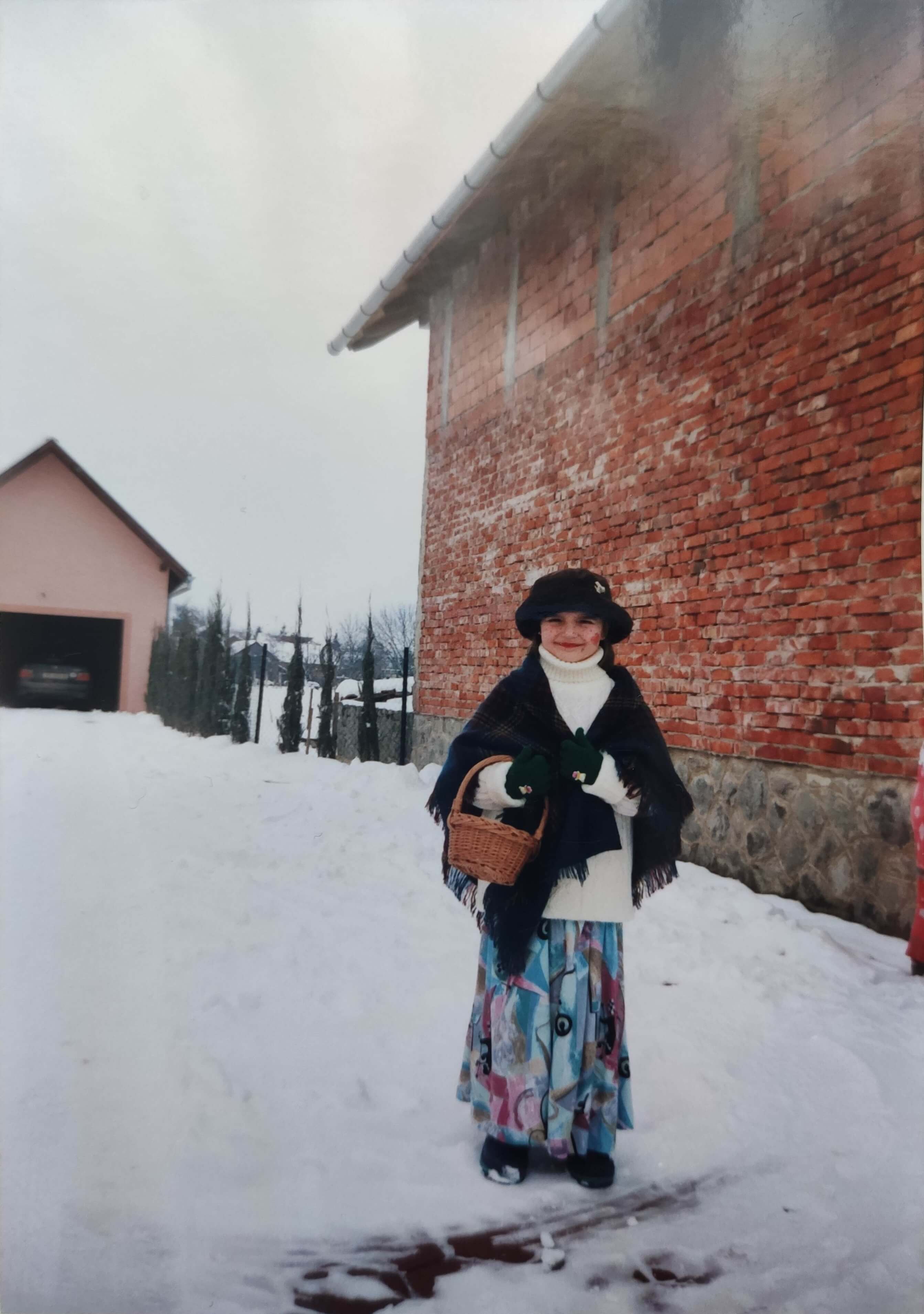
My sister ready for masquerade with her friends, at the beginning of 2000s - Private album
A huge part of the Carnival in Slavonia is the so-called Carnival riding (Pokladno jahanje) which is a tradition that goes back all the way back to the 18th century. Carnival riding came to prominence during Military Frontier (Vojna Krajina) and some Slavonian villages maintained it until after Second World War. The custom was revived after the Homeland War and again became one of the most important events in Slavonia. Riding through the village, the riders would stop at houses of certain families who treated them with Slavonian food and drinks and they usually repay them with a song. After leaving the host's house, the horsemen would sing “Domaćine, od srca ti hvala, što nam tvoja desna ruka dala” (Thank you, hosts, thank you from the bottom of our hearts, what your right hand has given us”). This type of celebration is still going strong and has more and more riders every year, in an effort to preserve the tradition and identity of Slavonia. What is also characteristic of this Carnival is that in some places in Slavonia masked plowmen come with the plow to plow village streets or yards and for that job they get rewarded with sausages, sweet cakes, and donuts (in Eastern Slavonian slang “krofne”) by hosts.
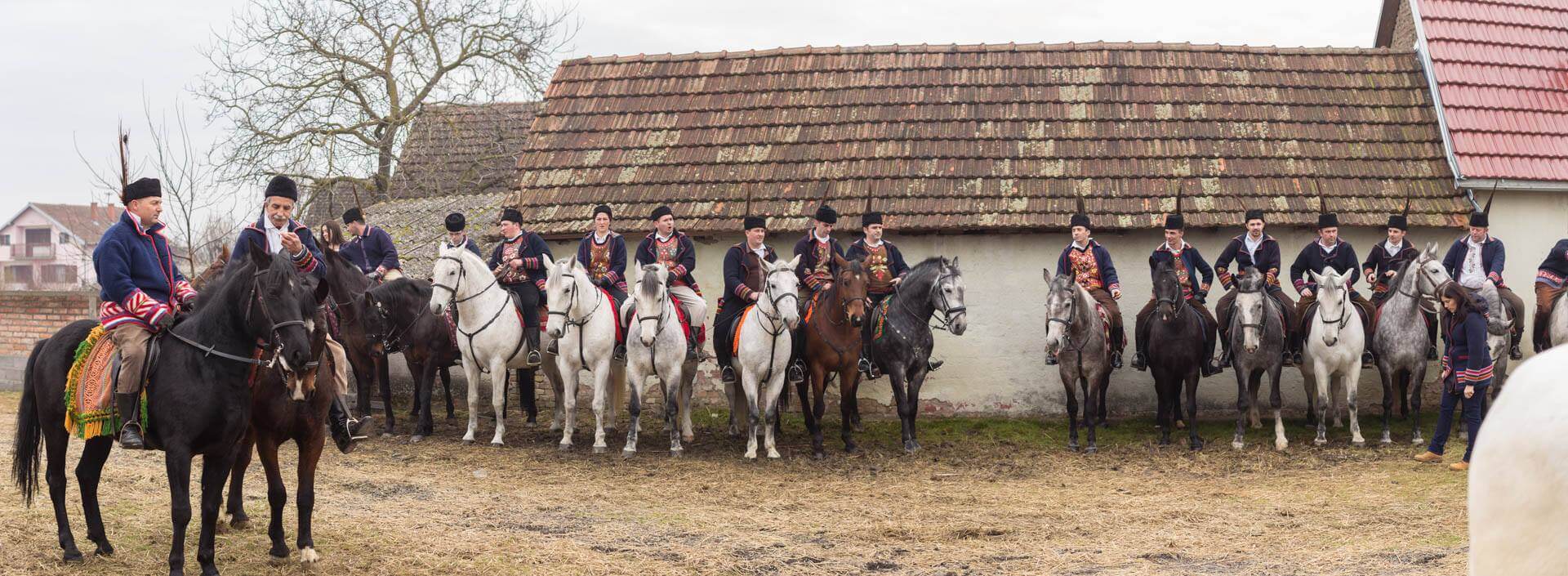
Horsemen getting ready to start their tour through the village - Photo Credit: Marko Miličević - načelnik Opčine Ivankovo, Facebook page
This event, as mentioned before, is an intro to Lent and lastly Easter. Apart from organized games and parties, Carnival is also a great place to introduce the traditional food and drinks Slavonia has to offer. However, that needs its own article. Until next time.
For more, check out our lifestyle section.
My Two-Day Adventure From Ivankovo to Zdenci: Travel Connection Issues in Slavonia
February 10, 2022 - After World War II, a lot of people migrated from Dalmatia, Herzegovina, and more to Slavonia looking for better lives. They mostly traveled with coal-fired trains that would take a week to get to their destination. However, that was in the 1950s and 1960s. In the 21st century, in 2022, my trip to Zdenci, a village located in the east of Virovitica - Podravina County, took me two days by public transportation - train. A look into the travel connection issues in Slavonia in the 21st century.
Railways and trains, as public transportation and a part of the economy, always had a huge role in Croatian history. The first railways in the territory of today’s Republic of Croatia were built in the 19th century, which connected Međimurje with Hungary and Slovenia, only 35 years after the first railway was built in England. Croatia, which was part of the other reigns at that time, realized its potential as a favorable traffic center that connected Southern Europe with the West and more. Slavonia has become part of one of the most important railway tracks named Corridor X - a Pan-European line that goes through Vinkovci, a city that became one of the most important railway centers in Europe. Older workers fondly remember tons and tons of cargo going through Vinkovci and full trains which would transport passengers every 4 minutes. They also highlight the extended travel which was caused by worn-out railways which can’t withstand newer locomotive trains and that impact can be especially seen on Vinkovci - Zagreb line. Because of that, the consequences were inevitable and the most loyal passengers switched to other types of transport.

Screenshot: Google Maps
Ivankovo being so close to Vinkovci benefited a lot in terms of connectivity and availability of lines and trains for traveling. Every hour there would be a train transporting to a specific destination. I have travelled by train my whole life. It is my favorite type of public transportation by far and still a huge part of life, not only mine but of every other resident of the Ivankovo district.
Finally, this is how my adventure started. My friend from Osijek and I decided to visit a mutual friend who lives in Zdenci and the only time we could go was Saturday, which is a doomed day for public transportation in Croatia - lack of lines in all available public transportation. However, that didn’t stop us, this is it, we’re going, now or never. After exhausting brainstorming, I decided to come a day earlier to my friend’s place, sleep there and catch a morning train to Zdenci - Orahovica. That was the only train in the morning that traveled for an hour and a half to our destination. How? Well, the line is originally going to the city of Virovitica and it stops in the city of Našice where it stays for almost an hour?! In the end, it was less than that but before that, we didn't realize why we stopped for almost half an hour in a village called Koška. God only knows why, but apparently, we waited because of the other train that was coming back on the same railway? I still don’t know the reason why.
After we finally started traveling again, there weren’t any obstacles in our way. We were finally coming to our destination. Unfortunately, there was another problem. Apparently, the station’s location isn’t in the city of Orahovica or the village of Zdenci, it’s in another village - Duga Međa. The walk to Zdenci, with half of the way without a footpath, takes approximately 40 minutes. Of course, we shrugged that possibility off and decided on a taxi which isn’t even in Orahovica or Zdenci - it’s in the village of Čačinci. Yes, another name of the place that even made our heads spin, I can only imagine the person reading this.
Back to the story. The taxi guy from Čačinci welcomed us, props to him, and drove us finally to our friend’s house. It was a great moment; we haven’t seen each other for over a year because of the pandemic and life in general. We talked, laughed, and hung out like the old times but the lack of public transportation had to cut our time together short. There was only one train available to Osijek around 3 pm that we couldn’t miss, because of my transportation home from Osijek to Vinkovci and friends' other plans. I traveled two days for two hours of socializing. It hurt so much. After slow travel to Osijek and finally coming to Vinkovci and realizing there isn’t any public transportation to Ivankovo after 3 pm, not even a bus (which is a discussion for another time), I took a taxi and paid another fee. I came home and my mother told me: “You traveled for two days to a place that takes an hour and a half by car, and hung out with your friends for two hours?! This looks like the 1960s, not 2020s.” And I looked at her and realized she was right.
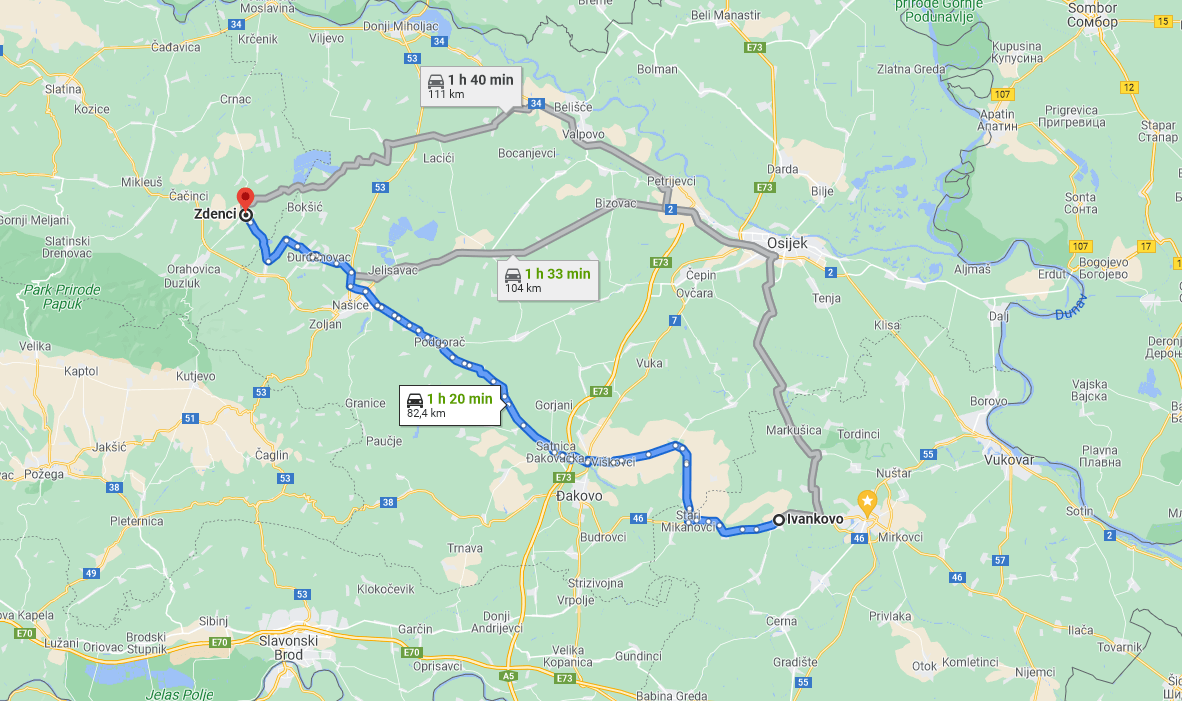
Screenshot: Google Maps
In the end, one more realization popped up in my head. The amount of money I spent going to Zdenci by train, with taxi fees and everything else, I could’ve easily paid for a cheap, discount flight to another country or go to Dubrovnik or Split by plane, possibly, even a discount two-way ticket. This wasn’t cross-country travel, we were literally going to another Slavonian place, which yes, seems far but it’s truly not. From Ivankovo to Zdenci, traveling by car, on the D515 road, that goes by the city of Đakovo, takes around an hour and a half (82,4 kilometers). From Osijek to Zdenci, it takes an hour without traffic (around 70 kilometers) and the railway has the same route as the roads and it took four hours more, including the travel back. This isn’t how it was before. How can we travel longer in 2022 than in the 1980s?
Slavonia always lived on railway infrastructure - most of the people still work there. It’s still a huge factor in our lives and not everyone has the possibility to own a car and drive it wherever. The lack of passengers led to fewer railway lines but lack of investment and nonsense renovating led to fewer of those same passengers. After thinking about everything my friend and I went through to see our friend for two hours; I came to this conclusion: get money for a drivers' license and buy a car. Hopefully, the future brings positive changes; the old love for train travel comes back with passengers that spent their youths traveling in them and future youth start bringing back the reputation this part of Croatia always had - one of the most important railway hubs in Europe.
For more on travel in Croatia, follow TCN's dedicated page.
Sports Culture in Slavonia: How One Tournament Became a Way of Life
30 January 2022 - Croatia, in comparison to other countries in Europe, is relatively small. However, what’s really beautiful about it is the diversity of every single region in terms of tradition, culture, the mentality of the people, and more. Sport fits that narrative as well. This is a story of how small Slavonian villages lived and still live through sports during summer. A look at sports culture in Slavonia.
When it comes to summer in Croatia, most of the residents in Vukovar - Srijem County think about how can they “escape” the unbearable Slavonian heat and relax on the beautiful Adriatic coast with no obligation to anything. Unfortunately, people who are unable to afford the trip to the coast stay in and brainstorm what to do to “kill” time. Summer sports events became one of them and stayed relevant even today. The main question is, when did this all start? How have these tournaments become so integral for residents of small Slavonian communities?

My father preparing for the football tournament in the early 70s, Private album/Dora Naletilić
According to Bijelić (2008) and his article The Beginning of Playing Football in Đakovo, “it was started by students who, over summer school holidays, stayed in the cities that did not abound that much entertainment for young people. Sports, or in this case, football, was supposed to enrich the social life of the place, expand the possibilities of creative expression and in socially acceptable way articulate the accumulated youthful energy.” There weren’t dressing rooms where participants could get changed in sports gear or leave their personal stuff. It was an open meadow with no shade, exposed from all angles. However, that did not stop anyone, they just wanted to play football.
Growing up in a Slavonian village during the 90s and 00s had its pros and cons but the biggest advantage was definitely sports tournaments that took place during summer school holidays. The anticipation could always be felt near the end of the school semester. Teams participating would be revealed and speculation would begin: Who is playing for which team? Who is leading them? Our neighbour? Someone’s brother? Sister? Cousin? Some guy from another village who was a professional athlete? It seems silly to the outsiders but for us, it was a highlight of the year. It started with Municipality Day, a village fair celebrating a local saint (in this case St. John the Baptist), an amusement park that entertained kids during the day and it continued until the evening when the summer tournament was about to start. It didn’t have a particularly fancy venue; a playing field made out of concrete suited for handball and bleachers which were made out of the same material. Nothing special. Until it was.
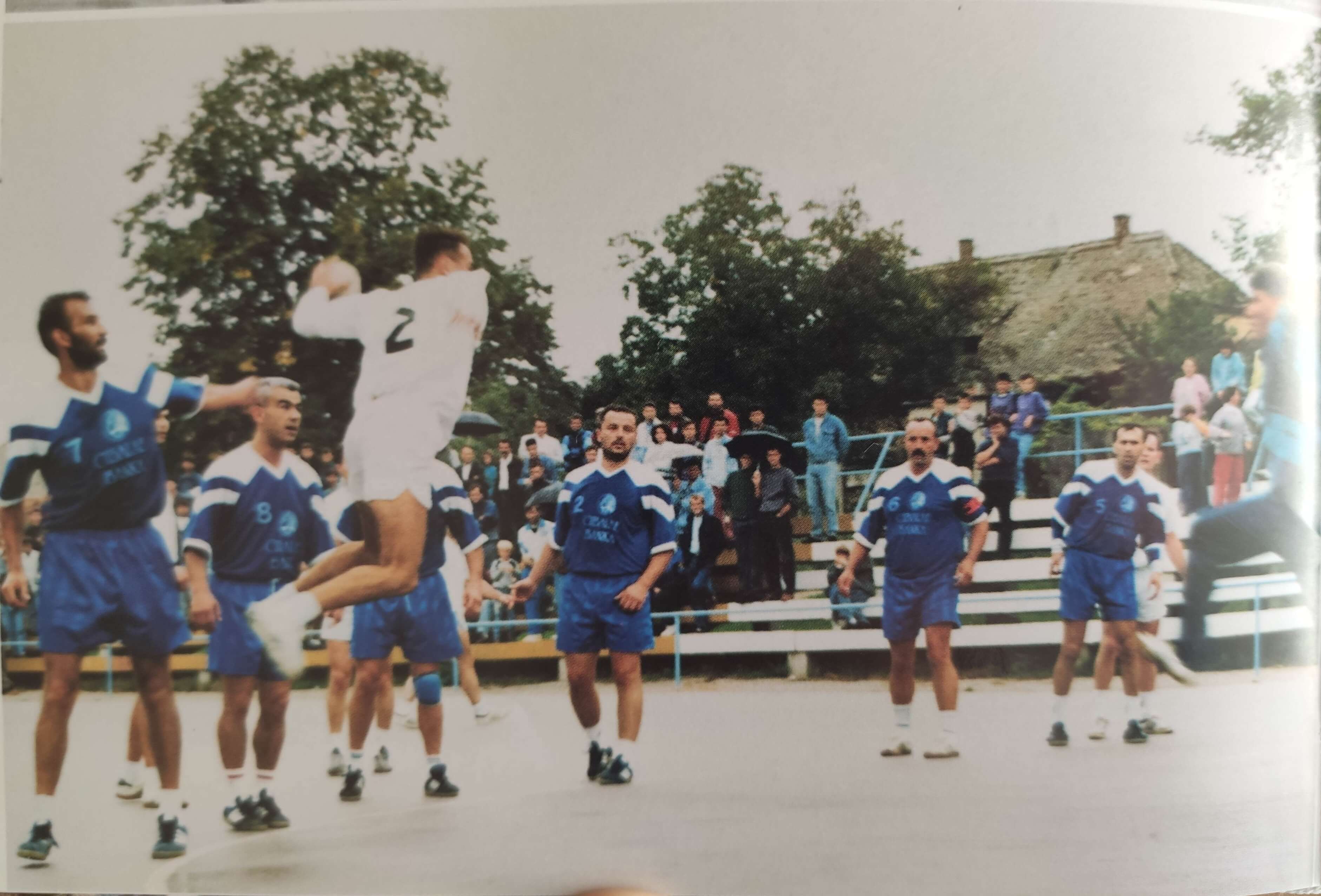
An old concrete field that was used for handball and football in the late 80s, "Rukometni klub u Ivankovu 1966 - 2016" book by Handball club "Cestorad" Ivankovo
The organization consisted of three main segments: the staff that kept the score and records of participants, sponsors of the venue, and of course snack bars, which were filled with local cuisine. When that was settled, the tournament could begin. The whole village of Ivankovo would participate in the event and support their own favorite teams. The supporting crowd would take out their own sirens that firefighters would use in their interventions and the atmosphere would seem like there was a huge national football cup game going on. Parents would drink their beers and nibble the seeds with their children, while the older folks would loudly comment on everything happening on the field. It was a picture-perfect small-town atmosphere that we (now young adults) think fondly of.
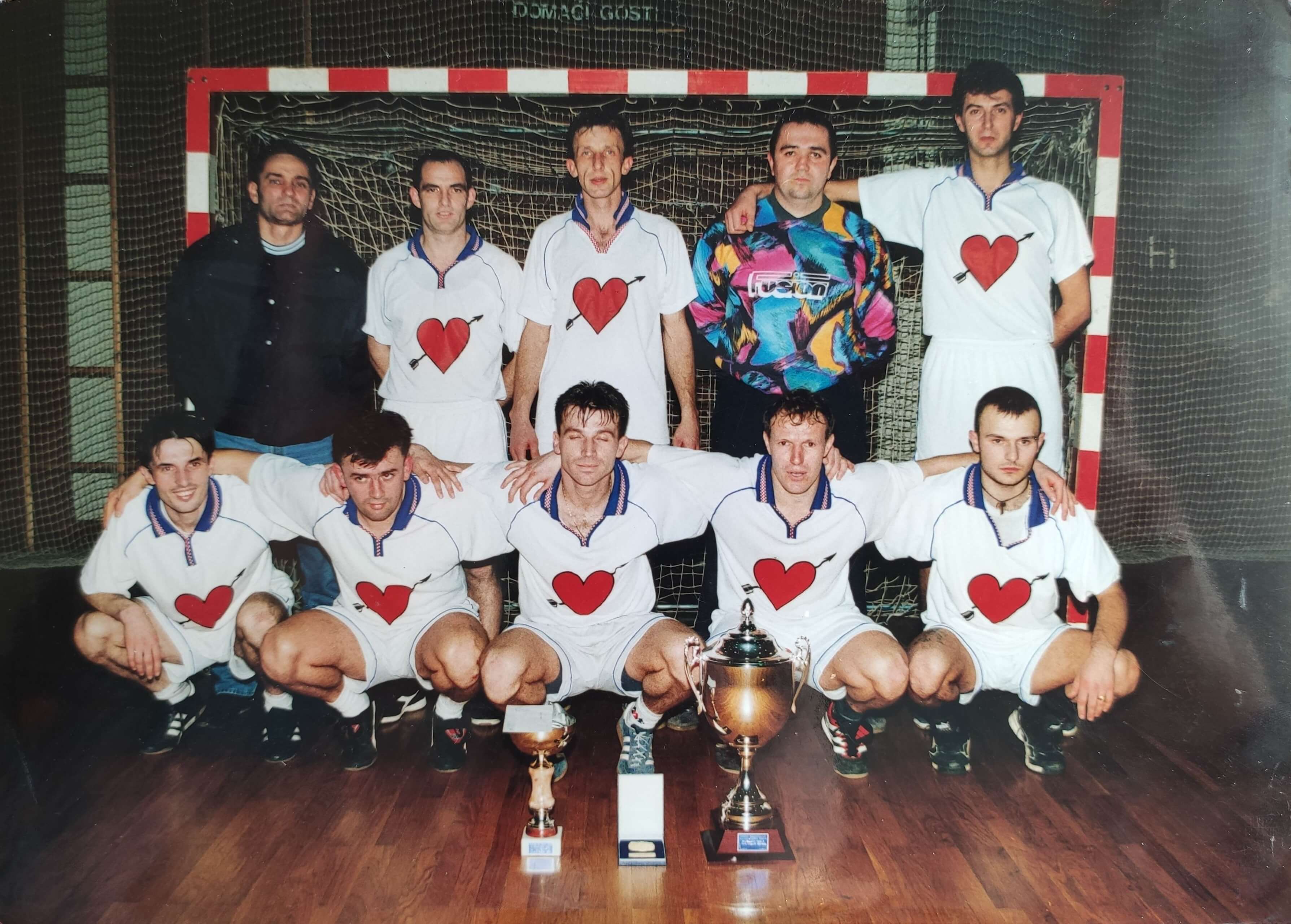
"Lutajuća srca" after winning the summer tournament, the early 2000s, Private photo album/Dora Naletilić
Looking through the old photos reminded me why I started loving sport in the first place. My father was constantly participating in villages sports tournaments, mostly football ones, where he would have his own team competing for the title of the best in the village. His team was called “Lutajuća srca” (Wandering hearts) and has won multiple tournaments over the years. One of the best feelings in my life was carrying that trophy across the field after excruciating penalties and the sound of the fellow villagers clapping and cheering.
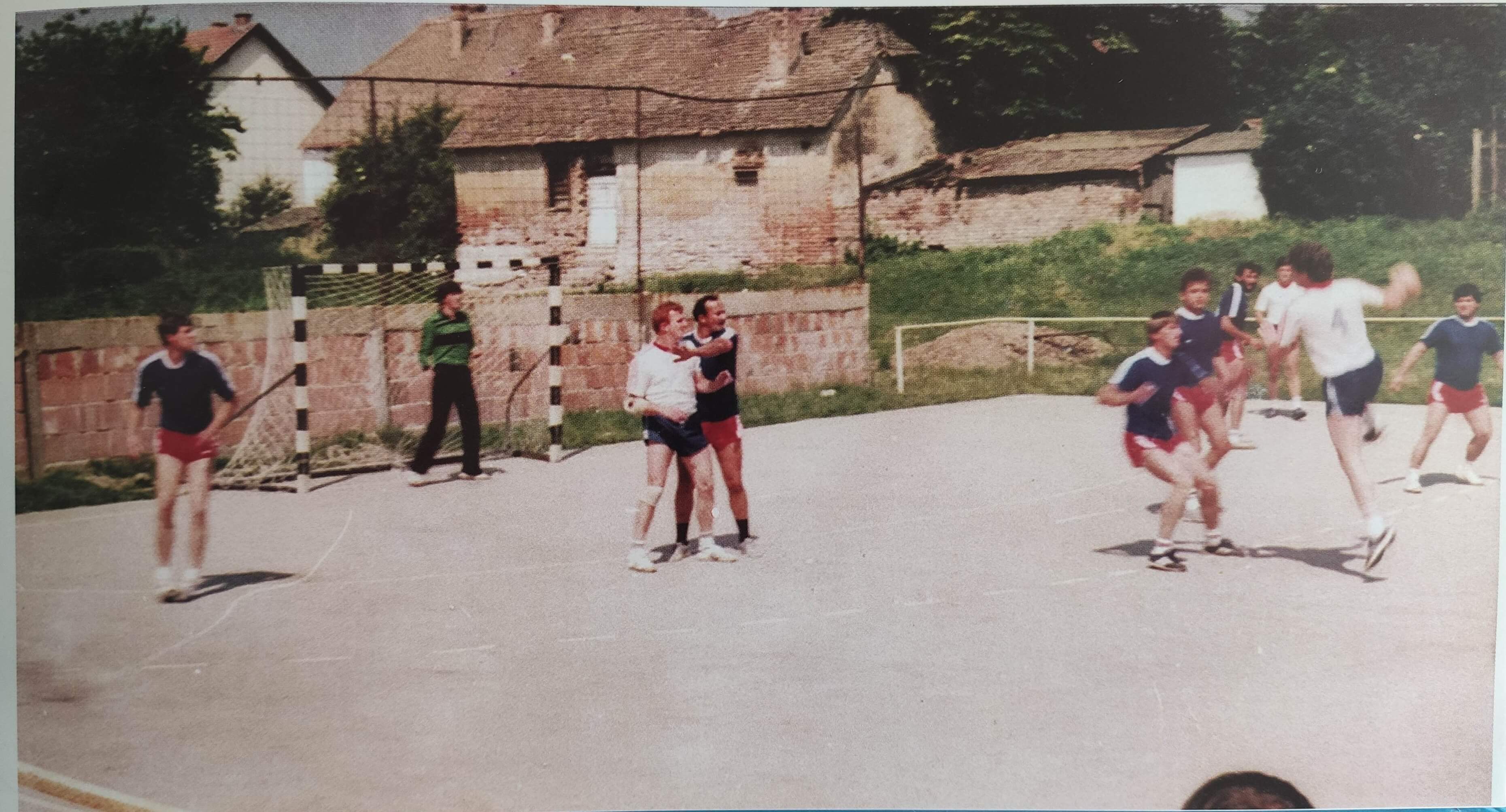
Old handball tournaments in 1986, "Rukometni klub u Ivankovu 1966 - 2016" book by Handball club "Cestorad" Ivankovo
Football wasn’t the only sport Ivankovo had to offer, handball always had and still has a big impact on sports fauna in this part of Slavonia. When the sports arena in Ivankovo was built, children and senior players finally had a venue where they could play their league games. After the mass, every Sunday morning people would go to the games and root for their team. Generations of families were always part of sports teams (including my brothers) and it stayed like that even today.

Sports arena opened in 2008, "Rukometni klub u Ivankovu 1966 - 2016" book by Handball club "Cestorad" Ivankovo
The annual summer tournament in Ivankovo maybe doesn’t have that charm it had 20-30 years ago but it’s still happening to this day. Sports games as a part of the “Summer in Ivankovo” are still going strong with other surrounding villages having their own traditional events. This only just shows that nothing in this country is taken for granted; if we love it, then we truly love it with all our hearts and souls. Sport is not just entertainment here, it’s the way of life. 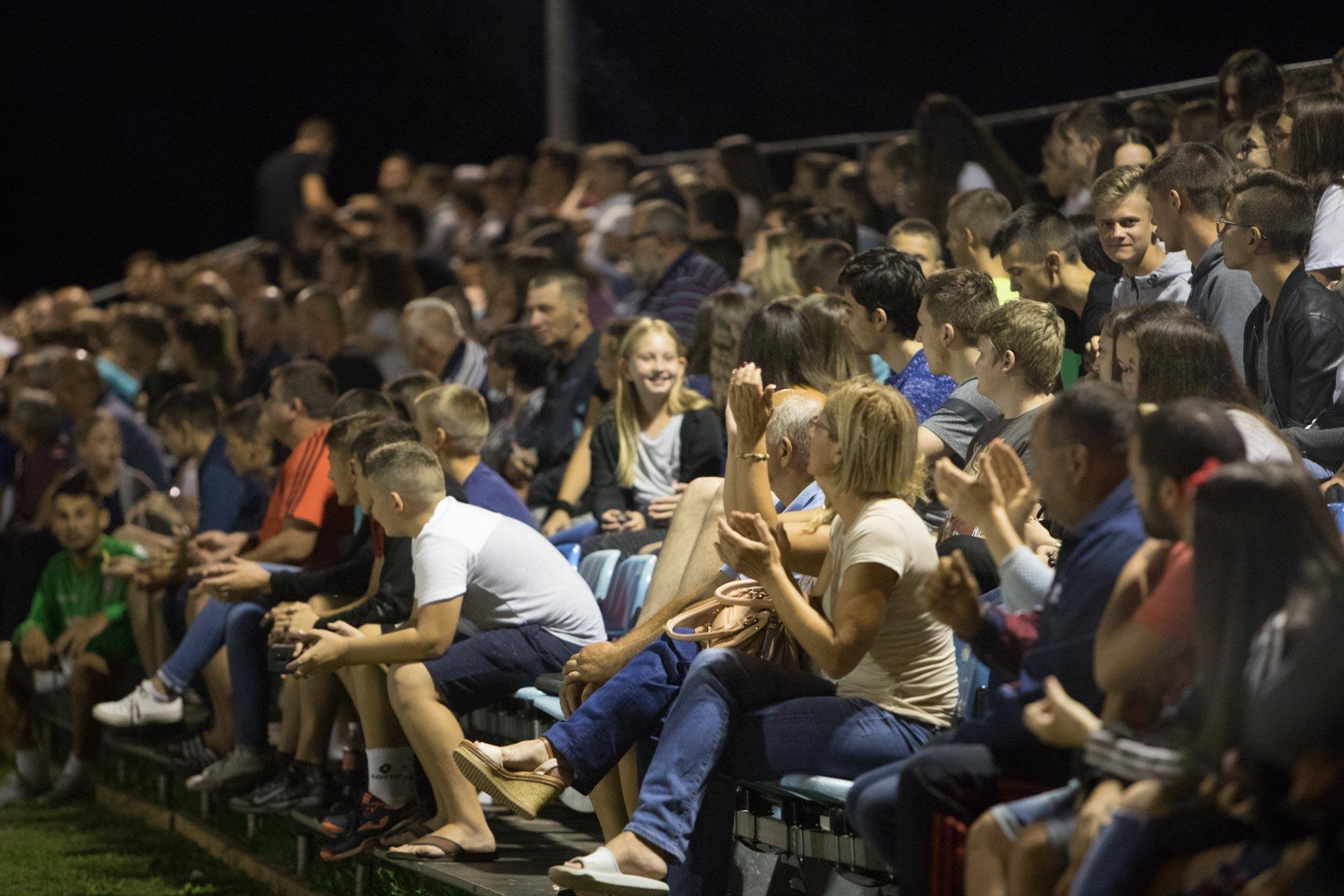
The crowd at a sports event during "Summer in Ivankovo", photo credit: Ivankovo.info
To read more about sport in Croatia, follow TCN’s dedicated page.
OLT Osijek to Transform: Museums, Sport Incubator, Olympic Swimming Pool
January the 26th, 2022 - Eastern Croatia is often (very wrongly) overlooked, and the City of Osijek is one town that is making a stand in several ways when it comes to turning its image around. The old OLT Osijek is set to undergo a transformation, with a unique sport incubator, museums and even an Olympic swimming pool thrown in.
As Poslovni Dnevnik/Suzana Varosanec writes, the praiseworthy revitalisation project of the OLT Osijek area, one of the largest projects being implemented in Osijek-Baranja County and in the City of Osijek, is still waiting for its visible construction phase to begin. It will most likely two more years before a large area in the very heart of Osijek is turned into a large construction site.
Therefore, the focus is on key activities that will enable this in connection with the development of the Urban Development Plan, which will be a prerequisite for defining the content in this area, which is the responsibility of the City of Osijek.
As part of the project entitled "The preparatory documentation for the strategic project for the revitalisation of the brownfield OLT Osijek area" in the amount of 2,777,500 kuna, and co-financed by the European Union (EU), conservation documentation also needs to be prepared.
The urban plan
This is the basis for the preparation of the urban-conservation base, which should be incorporated into the necessary spatial planning documentation. Conservation documentation, in addition to the catalog of all buildings, also includes various studies of research works and recordings of the existing condition for the buildings - these are the foundry with a lathe, an office, an administrative building, a tool shop and a water tower.
According to a request from Osijek-Baranja County, after the Urban Development Plan is drawn up and made, the project documentation will need to be prepared, and according to county prefect Ivan Anusic, they want to revive the OLT Osijek space which is located almost right in the city centre.
"In the immediate vicinity of the University Campus, OLT Osijek will receive additional support in terms of the scientific work needing to be done because our plan is to create a Science Research Centre, then a sports incubator where experts will work with children from an early age to guide them to the sport that suits them best, both according to their individual physical predispositions and according to their personal affinities.
There will also be support for the families of young athletes, as we've repeatedly witnessed that the top athletes we can truly be proud of in this county are the product of our own efforts and work, as well as family sacrifice. Our goal is to institutionalise this type of support,'' Anusic pointed out.
According to him, the construction of an Olympic swimming pool, which the City of Osijek currently lacks, is planned along with a number of halls, while the sport incubator will be the first of its kind in the wider area, so the new purpose of OLT Osijek will be of great importance for all of Eastern Croatia.
"It's also known that Osijek has a long tradition on the cultural scene, but in recent years there has been a lack of space for the development of alternative types of art. The plan also includes museums, an amphitheatre and various other content that will be generated in the time ahead as something which is necessary to improve the economic, scientific, social and cultural development of the city and the wider county,'' said County Prefect Anusic.
One of the basic preconditions for the realisation of all of this is the gift contract concluded last week between the state and this county for very valuable property that previously became the property of the state through their purchase in the bankruptcy of Osijek's failed metal company.
This is an area which boasts an abandoned and unused industrial complex, spanning a total area of 59,046 m2, and the plan is to be implemented over several phases of design and construction. The first stage of project implementation refers to the economic content, which consists of several components, while the second stage of the project is related to incentive housing for 1,600 inhabitants, or 380 apartments in total.
For more, check out Made in Croatia.
Hidden Village of Progress: Ivankovo - Great Example of Slavonia Full of Life
January 25, 2022 - There are many obstacles the Slavonia region faced in the last two decades, but one of the most prominent ones is the emigration of young people who do not see a future for them here. However, one particular village in the eastern interfluve of the Drava and Sava rivers in Vukovar-Srijem County stood out from the rest. Meet Ivankovo.
Ivankovo is located in Vukovar-Srijem County, west of the historical city of Vinkovci, along a busy road that has passed through that area since prehistoric times. The design reminds of a typical traditional Slavonian village; the houses are located on long narrow plots, built on a regulation line, and the background is used for agricultural purposes. In addition, there are villages Prkovci and Retkovci, which are also part of the Ivankovo Municipality. Furthermore, its geographical and traffic location connects cities like Đakovo, Osijek, Vinkovci, Vukovar. Also, the motorway A3 Bregana - Lipovac, industrial track, airport Klisa, the port of Vukovar, and neighbouring municipalities Vođinci, Stari Mikanovci, Andrijaševci, Cerna, and Jarmina. Historically, the municipality of Ivankovo was always highly populated (unusual for villages in Eastern Croatia) with, according to the 2011 census, 6,194 residents in Ivankovo, 1,263 residents in village Retkovci and 549 residents in Prkovci. However, the 2021 census showed that the emigration of people, especially young people, did not bypass Ivankovo. Only Vukovar-Srijem County has 19 percent fewer people than ten years prior, with just Ivankovo losing 1,091 residents. These devastating numbers only show how much this part of the country suffered since the Homeland War, and the possible potential Eastern Croatia can offer was neglected for decades. Recently, however, things started to change.
Croatia joined the European Union on the 1st of July 2013 and opened its borders to new opportunities, which was partly a curse if we consider the emigration, but Euro funds all of a sudden became available and small communities and districts like Ivankovo saw the opportunity to use its resources to develop their infrastructure. After the change of the government in 2017, hard work needed to begin. One of the first obstacles elected officials had to face were decrepit institution buildings (school, kindergarten, fire station), sacral objects, financial transactions pointlessly directed at projects that did not make any sense, engaging locals in public events, and keeping young residents and their potential families in the district of Ivankovo. This was only a drop in the ocean, but with the available European funds and fixes in municipalities' budgets, projects of developing neglected villages finally started.
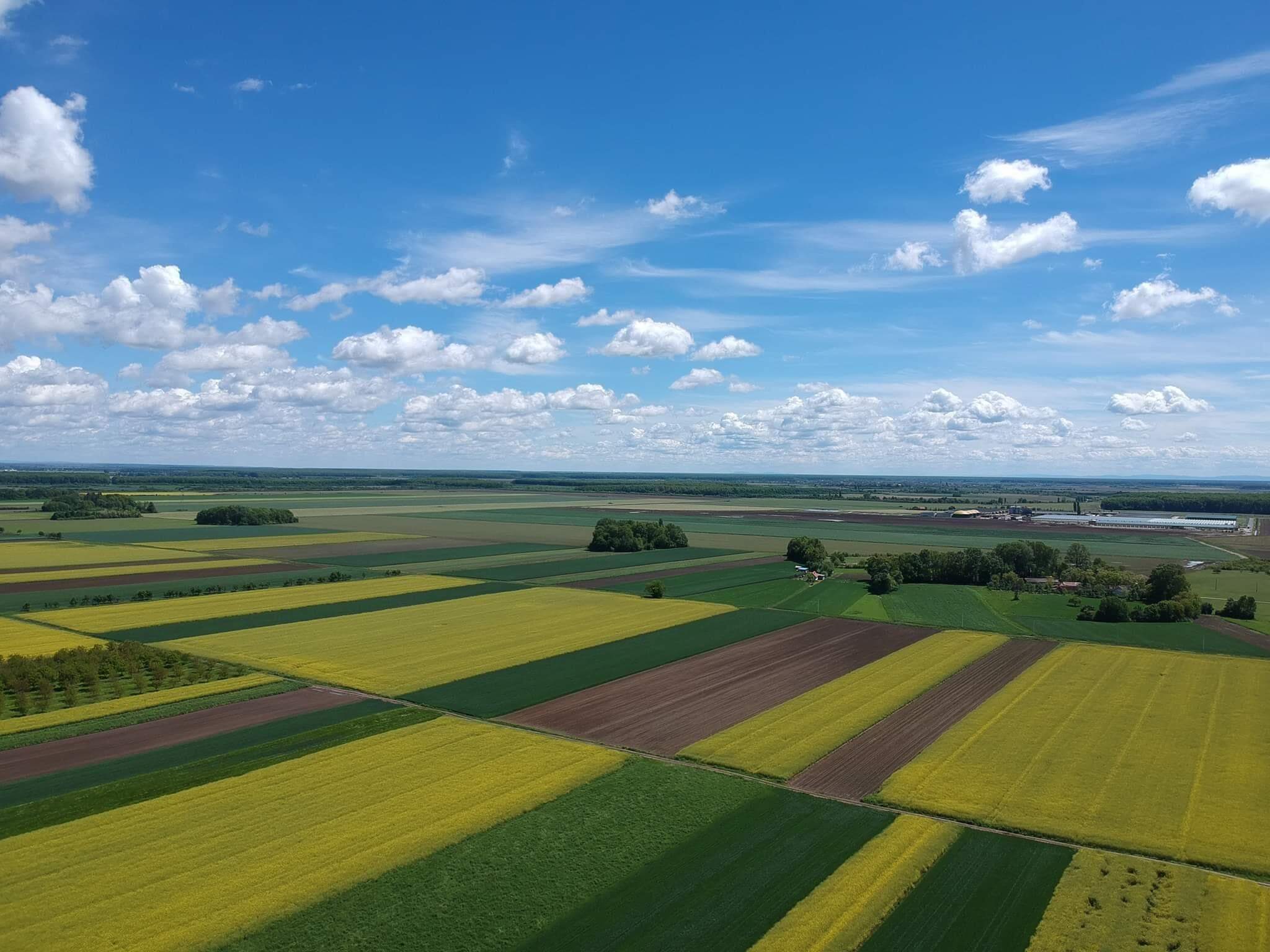
foto: Facebook/Ivankovo.info
The first big project happened at the Industrial Zone Ivankovo, which was, after many years, finally put into function and allowed local entrepreneurs to invest and develop their own establishments. This encouraged employment, of which 70 percent needed to be from the Municipality of Ivankovo.
Local utilities also needed a massive upgrade, so a communal society was formed and today employs 26 people from the Municipality, who take care of the village’s environment every day. Public spaces like children’s playgrounds, parks, and other areas were built and renovated. Furthermore, part of the Revitalization plan included planting 300 trees across the Municipality. The roads have been renovated, built where needed, and the sewer system finally connected with households across the villages of Ivankovo, Prkovci, and Retkovci. Waste management is still a huge problem across Croatia but the local government of Ivankovo, with the help of EU funds, enabled the construction of a recycling yard which highlights the need for sorting and recycling the waste. 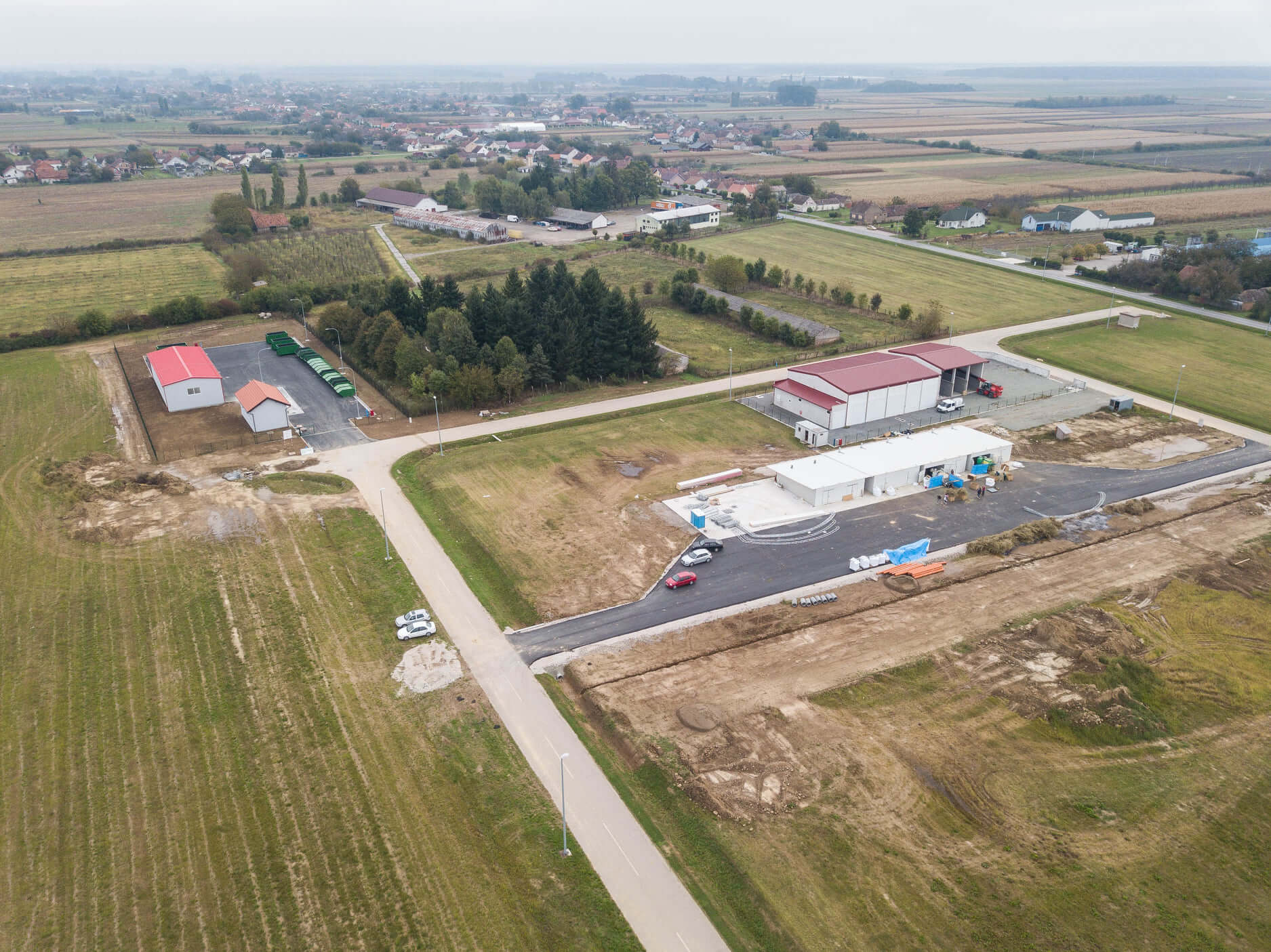
Industrial Zone Ivankovo, foto: Facebook/Marko Miličević - načelnik Općine Ivankovo
Social incentives: co-financing the purchase of houses for young families, infant benefits, free preschool educations, new kindergarten buildings, free student transportation, student scholarships, and other perks of the demographic policy all came into fruition since 2017, and it helped residents of Ivankovo immensely.
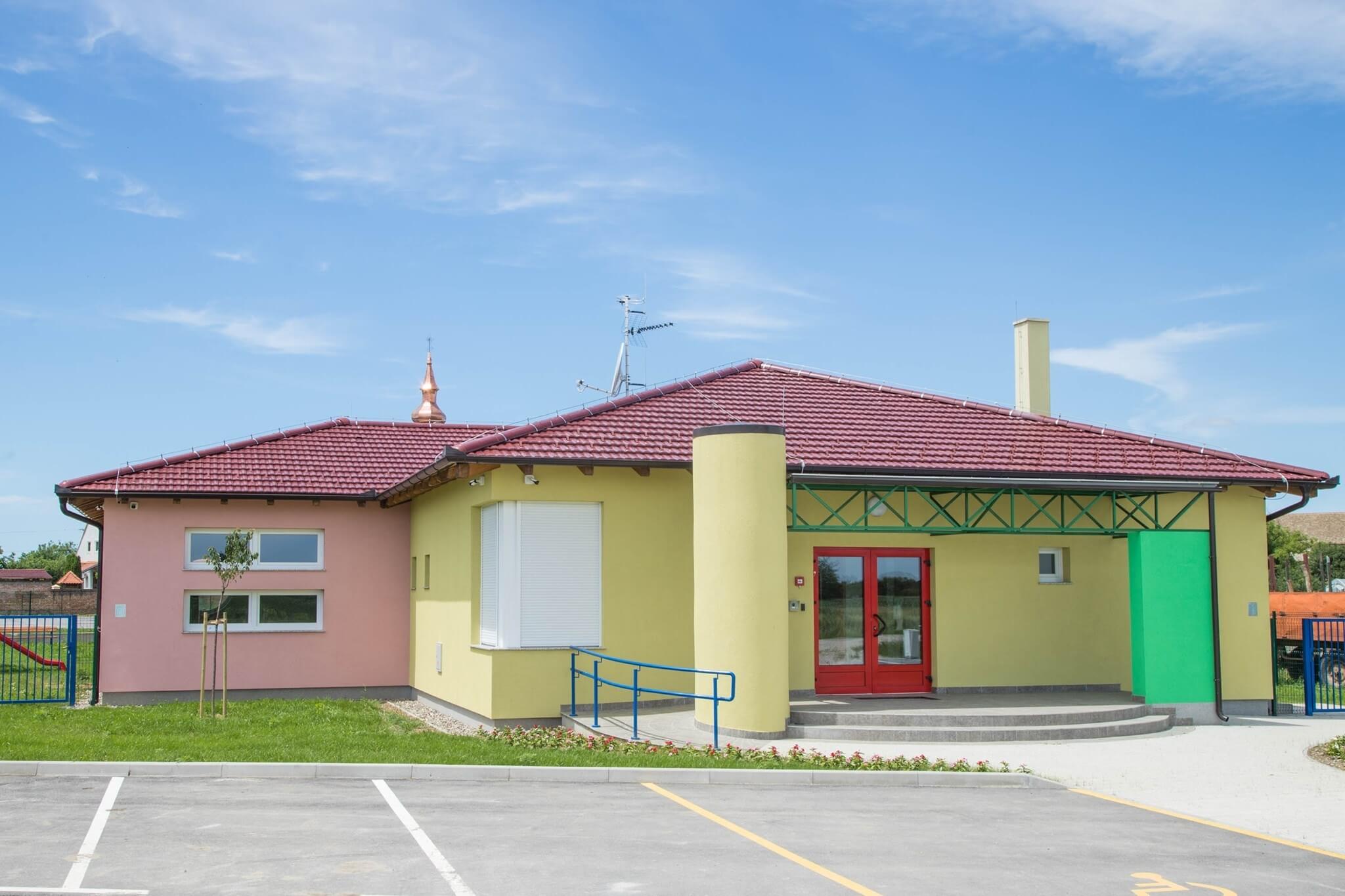
Newly Built Kindergarten Ivankovo, foto: Facebook/Dječji vrtić Ivankovo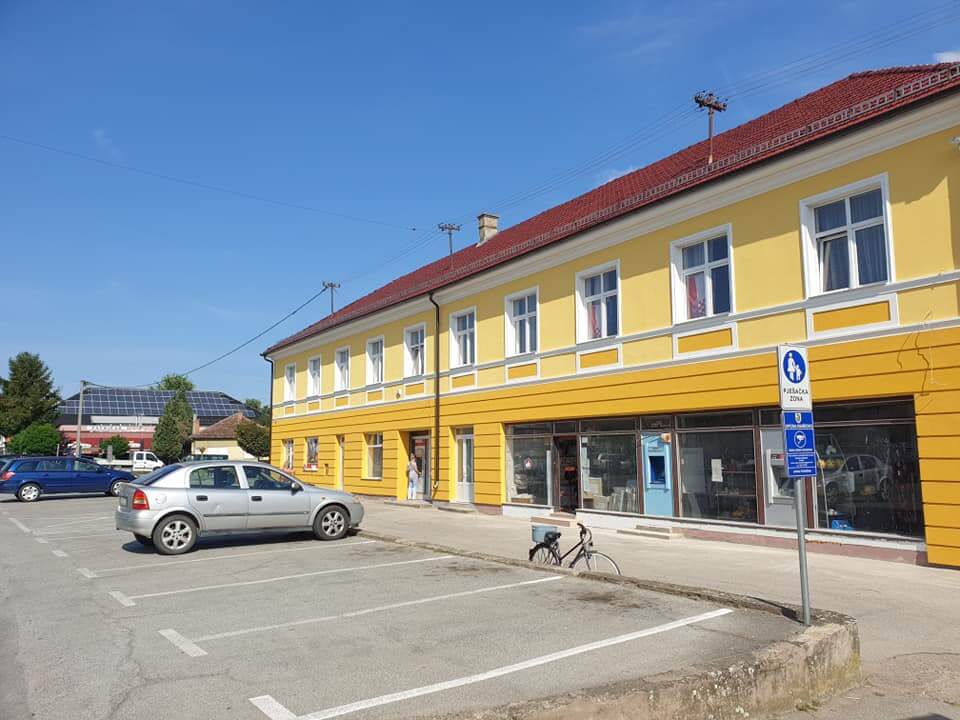
Renovated old government building, foto: Facebook/Marko Miličević - načelnik Općine Ivankovo
This is only a drop in the ocean that shows if people put in a little effort and genuinely care about the development of the community in which they reside, Slavonia can truly be better. When asked about these achievements and progress the Municipality went through the last few years, Mayor Marko Miličević says that “this is only the beginning. It was hard, we had to fix a lot of issues that were rooted here for years, but with the help of my colleagues and finding resources to finance our goals of development of this region, we started something that we can only continue to build on.”
He continues: “The most important part was listening to people, getting to know them again and recognizing their needs because before they weren’t being listened to.”
Plans seem ambitious as well: “This Municipality has so much potential and highly educated people, with more than 100 faculty students every year who are studying economics, IT, electrical engineering and computing, food technology, medicine, etc., which are all the fields that are the future of this country.” he says.
Furthermore: “We have numerous development projects in works that we want to be finished in the next few years: further development of Entrepreneurial Zone Ivankovo, a tourist, sports and recreation center, a retirement home, catering and tourist zone, etc.
Mayor Miličević ends on a hopeful note: “We have achieved the future of development in the Municipality of Ivankovo, and we plan to continue it.” 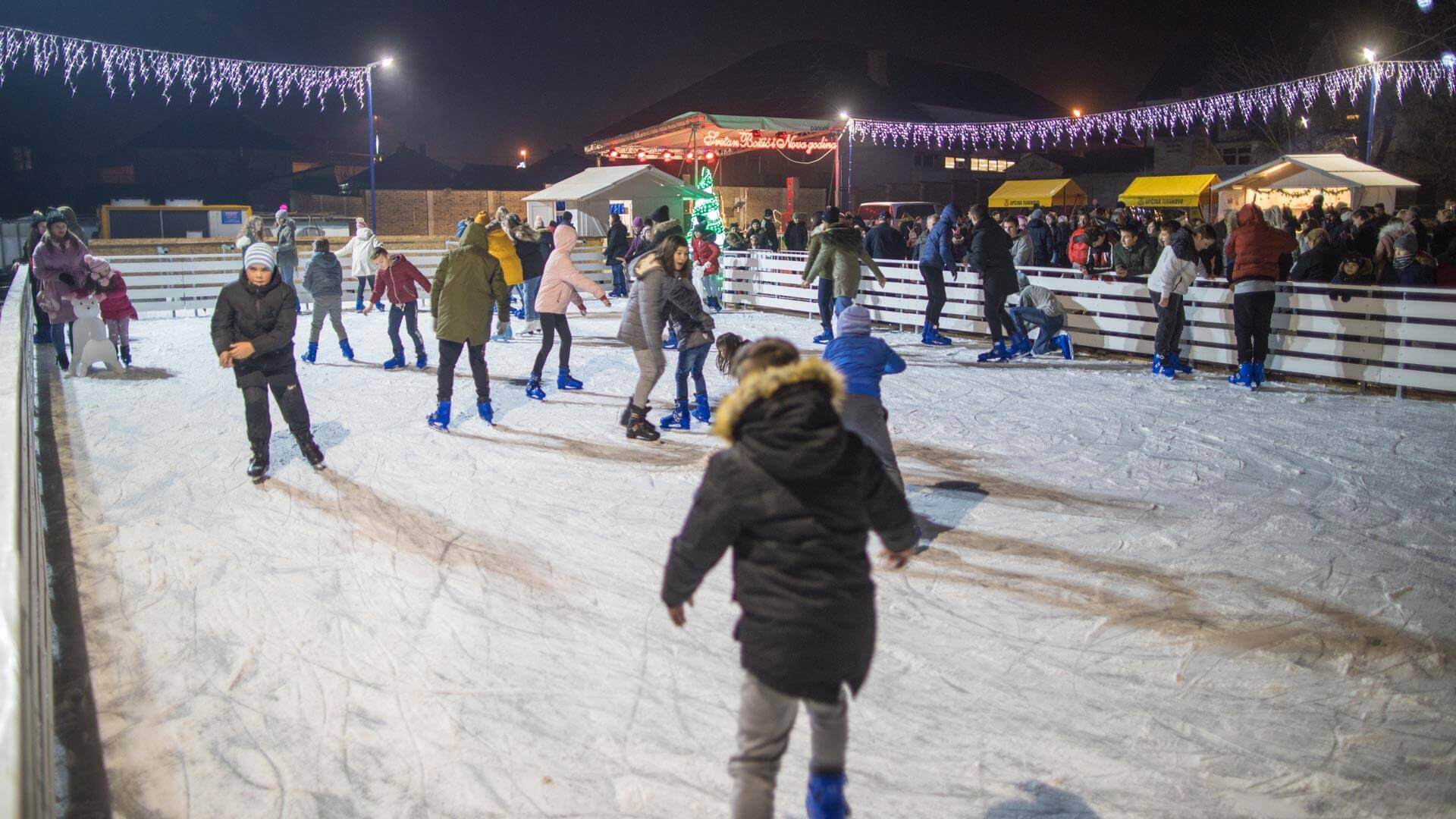
Winter Joys During Christmas Holidays, foto: Facebook/Marko Miličević - načelnik Općine Ivankovo
Sports recreation, social events, concerts, the inclusion of young people in said events, and more only shows that the district of Ivankovo finally livened up and restored a little bit of life that resided here 30 - 40 years ago. Multiple “parasites” wormed themselves in the core of Slavonia and slowly but surely exhausted the region to the limit. People settled for what was enough for them, for what was given to them, and some of them left because they couldn’t see their future here. Generations of high schoolers heard every day that there isn’t a place for them here in Slavonia, that there are many people like them who never found themselves here and had to leave because of it, and that they need to leave as well.
The hope for Slavonians has been stepped on for years, but the current changes slowly every day. Osijek started it, Vukovar and Vinkovci are following it. Still, a village like Ivankovo can only be an example of how much power its residents have and use their potential to make, how one former foreign politician said, Slavonia great again.
For more, check out our dedicatedlifestyle section.
Improving Croatian Tourism: 8 Key TCN Areas of Focus for 2022
December 23, 2021 - 2022 will be a year of change for tourism in Croatia. An overview of 8 key areas TCN will be focusing its efforts on improving Croatian tourism in 2022.
2021 has been a great year at TCN, as we diversified from a news portal into some other projects. There is such potential in so many areas in this country that I am constantly surprised at how few people I see exploring the opportunities. I know a few people who laughed when a certain Dutch expat announced he was going to grow tomatoes in northern Croatia, but having seen the project develop at first hand, it is heartening to see that such ideal dreams of Jan de Jong, Jerko Trogrlic and the team at CROP Hrvatska will become a reality.
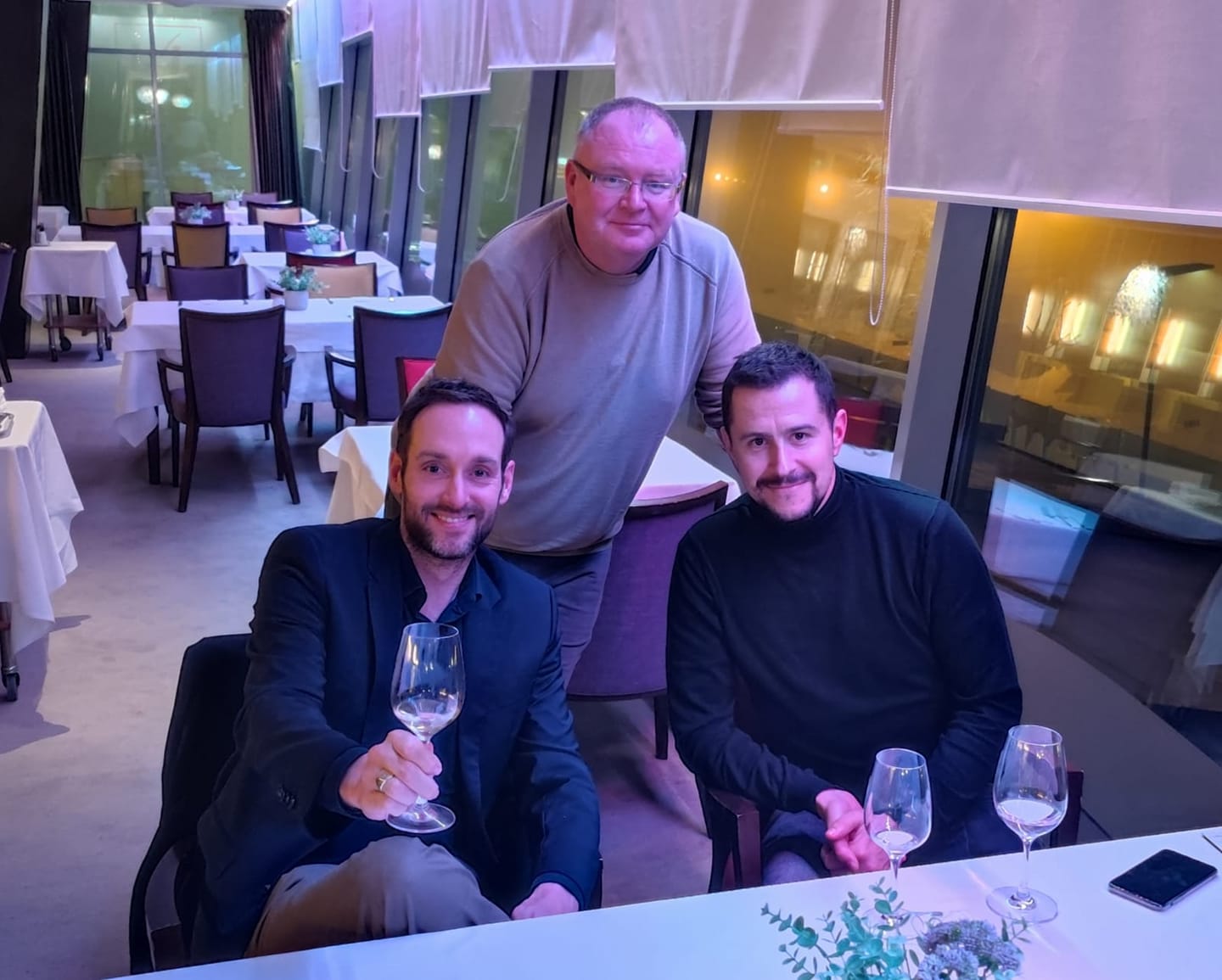
(The Slavonian Wannabe Tomato Growers Convention with CROP Hrvatksa, Osijek, December 2021)
And once it starts, the floodgates could open. Contrary to the general media portrayal, I genuinely think that this is an incredibly exciting time to be alive in Croatia. And I leave 2021 and enter 2022 with perhaps more energy, optimism and determination than ever before since I moved here permanently back in 2003.
Of course, Jan is a much more successful businessman than I could ever hope to be, and so my main focus in 2022 will be to develop the eco-system of sustainable tourism all over the country, 12 months a year, rather than watch the current lazy status quo which is slowly destroying Croatia's Adriatic jewels.
It has been another completely random 12 months at TCN. Just as I never expected to be named International Medical Travel Journalist of the Year in Malaysia a year ago, so too I did not expect to be giving a keynote speech at Digital Nomad Week based out of Bali on VIP Day almost exactly a year later - you can see the first presentation of our new CROMADS platform during my online presentation above.
2021 was a year of awards and lawsuits for TCN. A total of 11 international awards for projects that we were partners in, and an impressive 3 lawsuits, the first in my life (I don't count the one publicly announced in 2018 by Mayor of Jelsa, Niksa Peronja, as it never arrived). Seven awards for the Total Croatia Travel INFO Viber community, delivered in partnership with Manjgura and Mediacor (including 3 at the Polaris Awards in London), 2 for Zagreb Digital Nomad Week with Saltwater Nomads and Zagreb Tourist Board, and 2 for Dubrovnik Digital Nomads-in-Residence program with Saltwater Nomads, City of Dubrovnik and Dubrovnik Tourist Board.
But as nice as it was to win the awards, it was actually the lawsuits which gave me the inspiration for a new direction for TCN. If our constructive criticism was not only read by the Kings of Accidental Tourism, but bothered them so much that they were prepared to sue me for 100,000 kuna, perhaps I had a voice that was being heard further than I had imagined.

I am certainly very grateful to the Kings for the lawsuits. Apart from being described by one journalist as the biggest PR own goal in the history of the Croatian National Tourist Board, it was also the best free promotion TCN has ever had (thank you!), as a staggering 16,000 people took part in an online poll by Index.hr after the story hit all the major news networks.
If the Kings were that sensitive to a few words, what might happen if we publicly started pushing a few initiatives via TCN to see what stuck, and what progress we could make? The lawsuits will be entering their third calendar year next month, and you can follow progress every step of the way in our Diary of a Croatian Lawsuit feature, which will probably go on for years until we win in the European courts in Strasbourg. TCN promo budget 2022 - 2026 - tick.
But it seems more and more people are recognising TCN and the various initiatives we are pushing to celebrate the little guy and connect the eco-system outside the crumbling walls of the Mighty State of Uhljebistan. It was an honour earlier this week, for example, to receive an invitation from His Excellency Raj Srivastava, Indian Ambassador to Croatia to the launch of the India-Croatia Startup Bridge. Even more so when the Ambassador told me he was a TCN reader and that some of our articles celebrating Croatian startups influenced his thinking on this initiative. It is a great initiative, and I look forward to TCN reporting on various successes.
Rather than just reporting on the news and blogging about the latest lawsuit postponement by the Kings (Read more in Diary of a Croatian Lawsuit: 50 Lawyers, No Secretary, No Hearing), I started to think about ways that TCN could advocate for positive change in some targeted niches. Although I am not a tourism expert, I am getting to know Croatian tourism very well and travel extensively. Meeting so many people from all walks of life has helped me form a few conclusions on how we could improve a few things.
As we take a break for Christmas (TCN will be offline from midnight tonight until December 28), here are 8 key areas we will be focusing on in 2022, in addition to delivering you your daily Croatian news in English.
Split Winter Tourism Roundtable
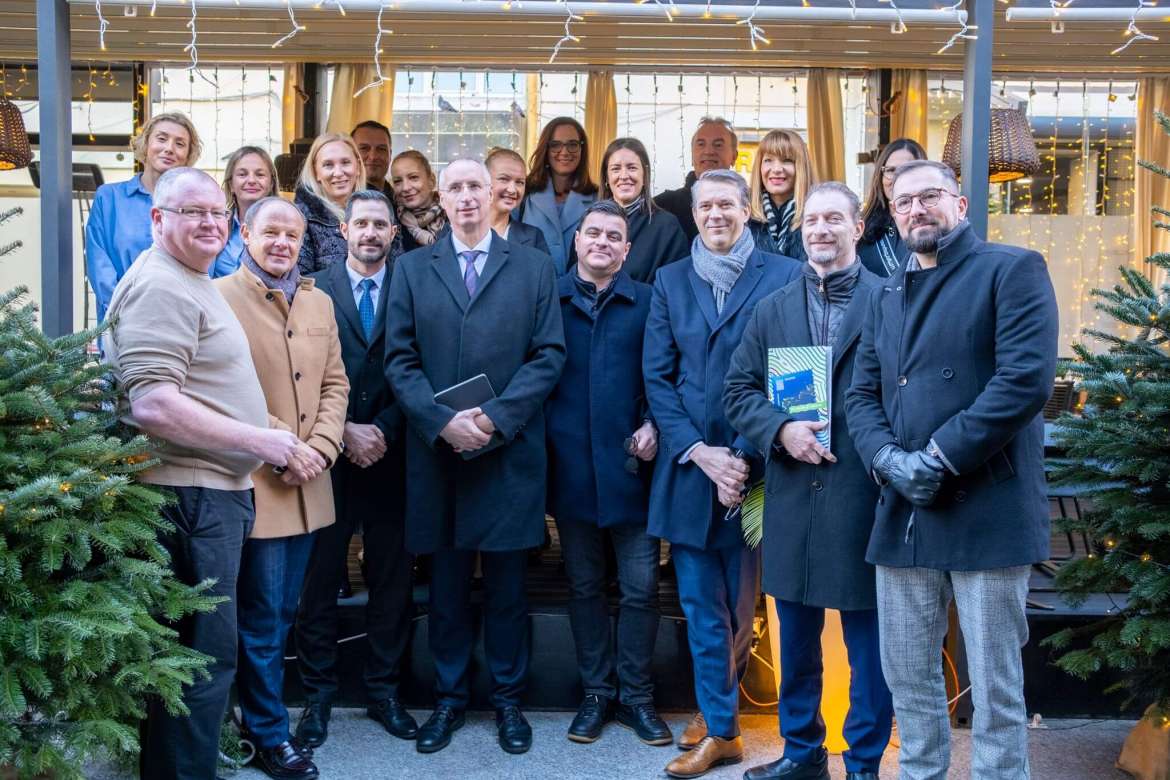
After posting a few TCN articles on the potential of Split winter tourism and questions why we no longer have much, some of the private Split tourism operators came up with a suggestion that TCN host a winter tourism roundtable, inviting all key stakeholders (including the Mayor of Split, Split Dalmatia County, regional and city tourist board director, Split Airport, State Secretary of the Ministry of Tourism and Sports, GMs of Split's 5-star hotels, representatives from the restaurant, hotel, hostel and MICE sectors, and tourism consultants) to have an open exchange of ideas in search of a way forward.
Not only did everyone invited come, but they all engaged and left an excellent lunch at CHOPS Grill with the desire to try. We meet again in January. Special thanks to Jasmina Kruscic, Jelena Tabak, Mare Mustapic, Daniela Rogulj, Mario Seric and MIchael Freer for pushing this initiative. Let's see 2022 deliver the first results. You can read more in Reflections on the First TCN Split Winter Tourism Roundtable.
Vukovar Card and Vukovar 365, Full of Life
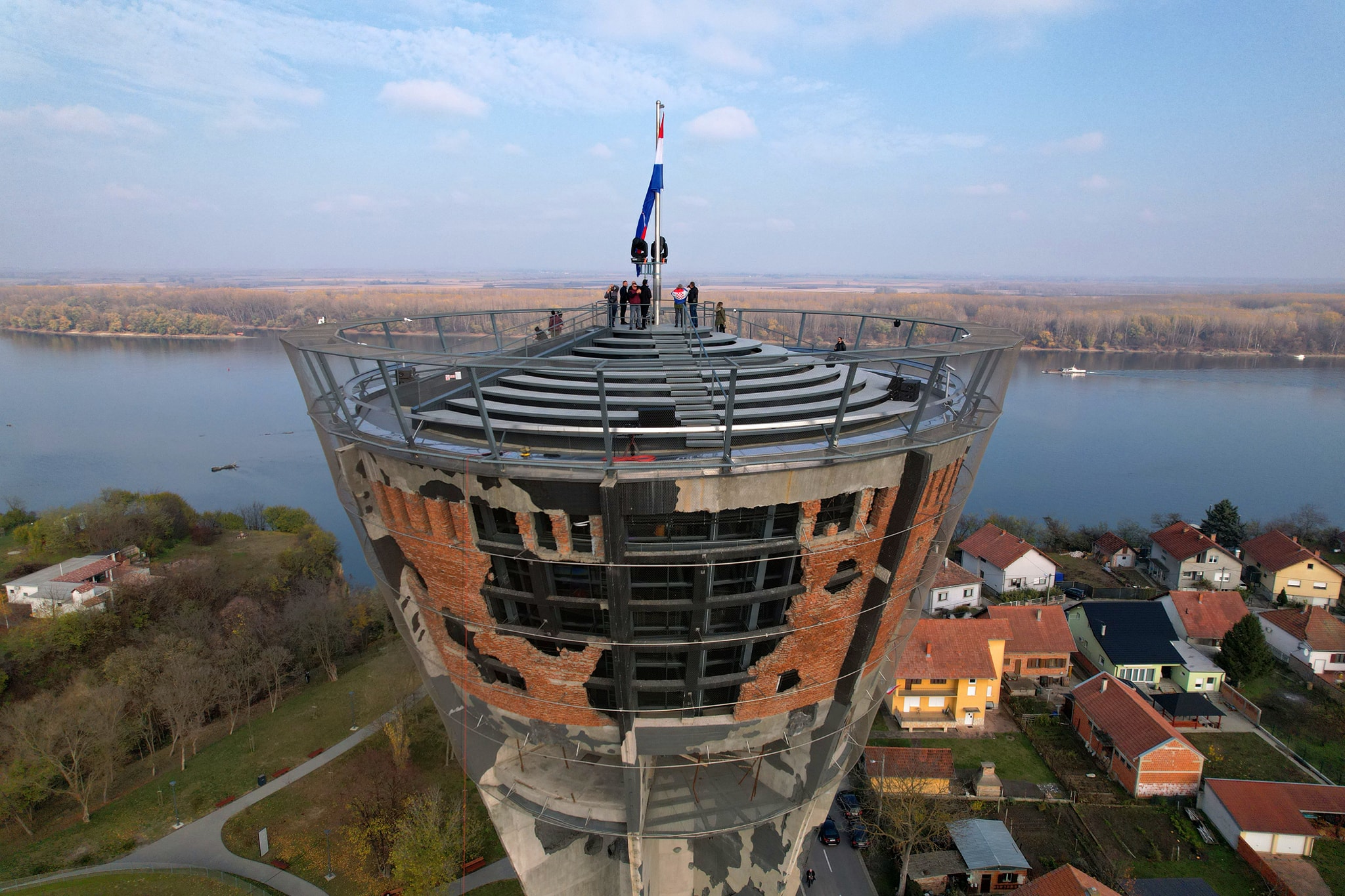
How many of you have been to Vukovar on any other date than November 18?
Having been to Vukovar Remembrance Day in 2019 and 2021, as well as several other visits, I came up with a suggestion called the Vukovar Card, a chance for people who change their Facebook status every November 18 for a day to do something more concrete (Vukovar Card: Support Local Economy Rather than Temporary Facebook Status). I was very grateful for the positive reaction and support of regional tourist board directors Ivana Juric and Rujana Busic Srpak, who devised a Vukovar Card 7-day itinerary through the magic of Vukovar Srijem and Osijek Baranja Counties. I sent this to Minister of Tourism Nikolina Brnjac and State Secretary Tonci Glavina with a request for a meeting to develop the concept.
That meeting will take place on January 10 at the Ministry of Tourism and Sports, and I was encouraged by Tonci's positive initial feedback at the Split winter tourism roundtable.
If you are interested to know more about the new Vukovar and the people and businesses framing a brighter future, follow the TCN series, Vukovar 365, Full of Life, with new TCN writer Katarina Andjelkovic from Vukovar.
Digital Nomads

The growth of the Croatian digital nomad story has been one of the highlights of my year. So much positive energy, innovative ideas, fabulous people and unforgettable experiences - it has been a privilege to be part of the journey. Working with Jan de Jong, Saltwater Nomads, the Digital Nomad Association, the Digital Nomads Croatia Facebook group, Swanky Travel, Zagreb Tourist Board, the City of Dubrovnik, Dubrovnik Tourist Board, Doma Zagreb Aparthotel, and others has been one of the undoubted highlights of 2021. Zagreb Digital Nomad Week & Ambassador Program and Dubrovnik Digital Nomads-in-Residence program complemented Jan's visa initiative and has helped put Croatia well and truly on the digital nomad map.
2022 will be more of the same... and more. Exciting initiatives in both Zagreb and Dubrovnik will be announced in early 2022, and if we can dot the Is and cross the Ts on a couple of other projects, things could get very interesting. It seems that next year will have me travelling internationally to promote the Croatian digital nomad story, with Digital Nomad Festival in Turkey in May, and Digital Nomad Summit in Bali in September already in the diary.
Medical tourism and digital nomads
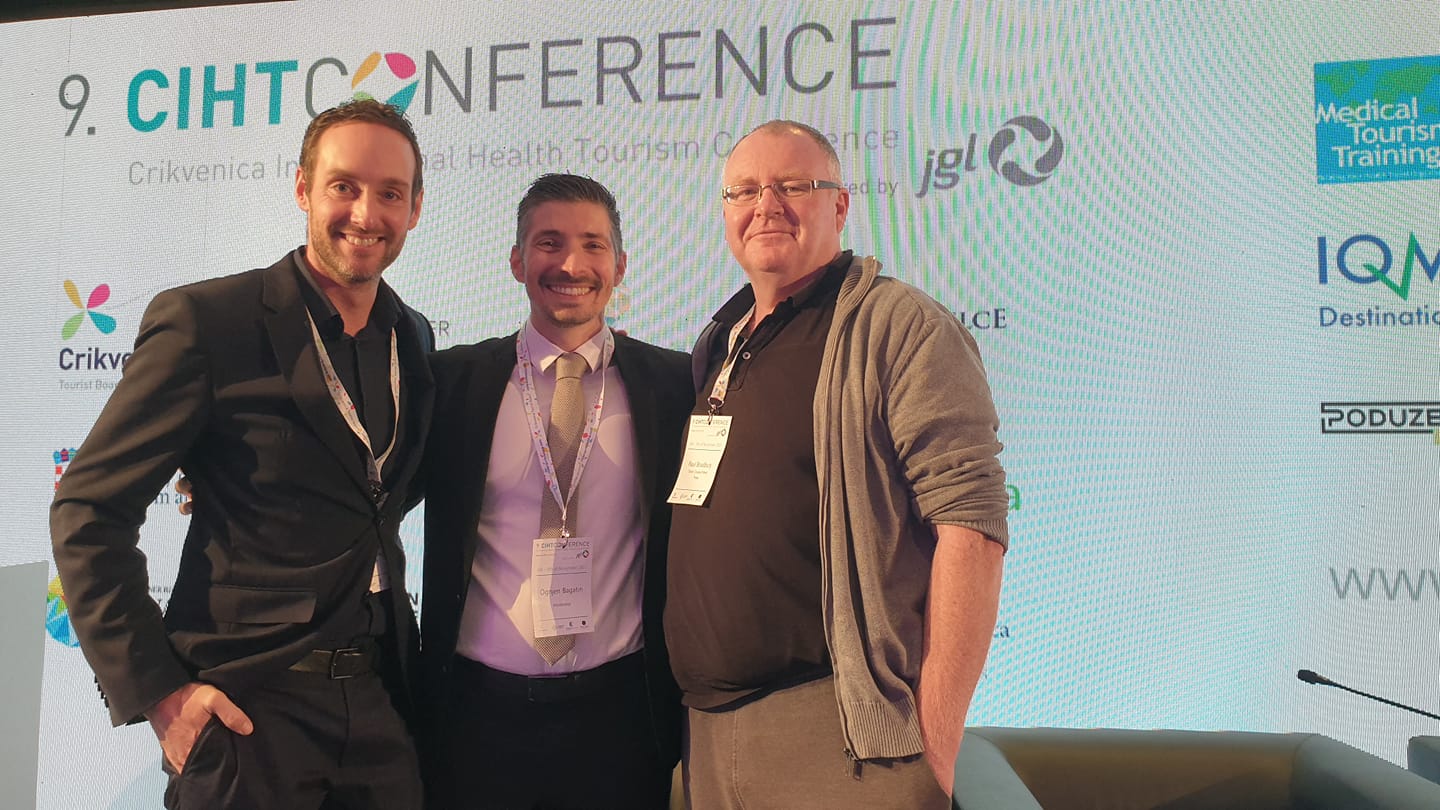
2022 will see the 10th anniversary of my favourite conference in Croatia, the annual Crikvenica International Health Tourism conference in Crikvenica. CIHT has been good to me over the years, giving me my first exposure to the global medical tourism community (and leading to those awards in Malaysia). The pioneering work of Ognjen Bagatin and the Kvarner Health Tourism Cluster have placed Croatia firmly on the medical tourism map, and after the major blip that is the pandemic, it is time to renew efforts. You can read a report on CIHT 2021 in Kvarner Full of Health Tourism Opportunity, as CIHT 2021 Shines.
A major new medical tourism opportunity has presented itself since 2019, one which I will be pushing hard - digital nomads. Rather than having to work hard to attract foreign patients to come to Croatia for treatment, why not instead spend less energy informing all the nomads who are already here how Croatian medical tourism can fix their medical issues at a fraction of the price back home. No need to travel, for they are already here.
The potential of the Kvarner region for health tourism is huge, and there is a much underutilised airport on Krk, Rijeka Airport. An issue I will also discuss with Minister Brnjac on January 10, as she is a transport expert.
Spreading the Truth about Slavonia, Full of Life

The biggest surprise of 2021 for me was not only how full of life Slavonia is, but how ignorant the rest of Croatia is about what is really out east in their own country. I was shocked at how few of my Zagreb friends who are among the 200,000 Croats who go skiing abroad each year had ever been to Slavonia and the East. With such little local knowledge, how can we expect tourists to know?
Lots of activity coming next year on this, including a fun survey on the streets of Zagreb to highlight the gap in knowledge. Here are two questions from the survey to get you in the mood. How many of you can answer both:
1. What is the main town in Baranja?
2. Can you name three famous buildings in eastern Croatia, not including the Vukovar Water Tower?
Want a taster of what you are missing? Read more in Time to Tell the Truth about Slavonia Full of Life.
Danube Drone Days
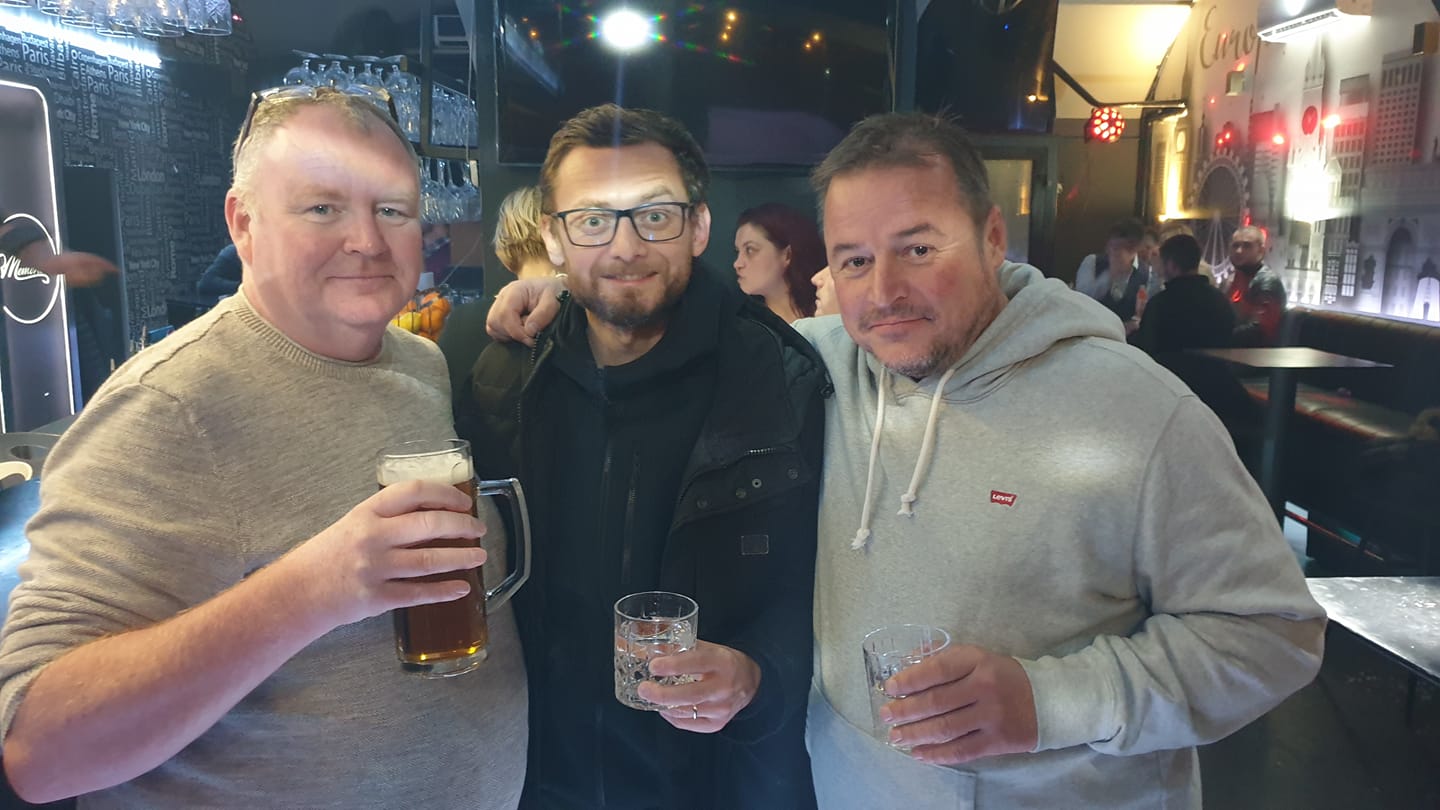
What happens when you meet an English businessman over breakfast at your hotel in Osijek in November?
Sometimes it leads to a night of sushi and gin in the company of the CEO or Orqa, three drone geeks, and a plan to promote Slavonia and the Danube with some of the best drone pilots in the world.
I love the concept of Danube Drone Days, and I am looking forward to working with these two geeks above to make it a reality.
CROMADS
Our new baby. What more can I say, but watch the official promo vid above, and check out www.cromads.com after Christmas for more. This is going to be fun.
Total Croatia Travel Portal
2021 also saw TCN launch its sister site, Total Croatia, a multi-lingual tourism information platform answering the questions people are asking. Launching in May, I was perhaps a little ambitious wanting to be the leading portal by the summer, but we are working hard behind the scenes to make sure Total Croatia's first full year in 2022 will be a big one. You can check it out here.
And that - more or less - is that. If you are interested in getting involved to build the eco-system outside the crumbling walls of the Mighty State of Uhljebistan, drop me a line at This email address is being protected from spambots. You need JavaScript enabled to view it. Subject TCN 2022, explaining how you can help and what you can offer.
Enough from my side, except to thank you all for your company, interest and support in 2021. We have a great readership, and I even enjoy the contributions of the trolls these days.
Things are starting to move slowly but surely. The default negative mindset is being challenged by new ideas and shoots of positivity. Croatia is a great country with a really bright future once we overhaul the current system.
And you will be able to read all about it on TCN in 2022.
Cheers!
TCN will be offline from midnight tonight until December 28. Merry Christmas to All.
Osijek Christmas Tram Is the Brightest Tram in Croatia
December 10, 2021 - The Osijek Christmas tram ride is a unique Advent experience in the Slavonian metropolis. This year, there are two appropriately decorated trams on the regular line that you can catch every day and experience an unforgettable Advent ride through the city on the Drava, which began in 2011.
Recognizable, traditional, the brightest tram in Croatia, the Osijek Christmas tram is visited by almost 15,000 people in the season, and this year it shone in full glory, reports Turističke Priče.
You can find the schedule of the holiday tram at this LINK.
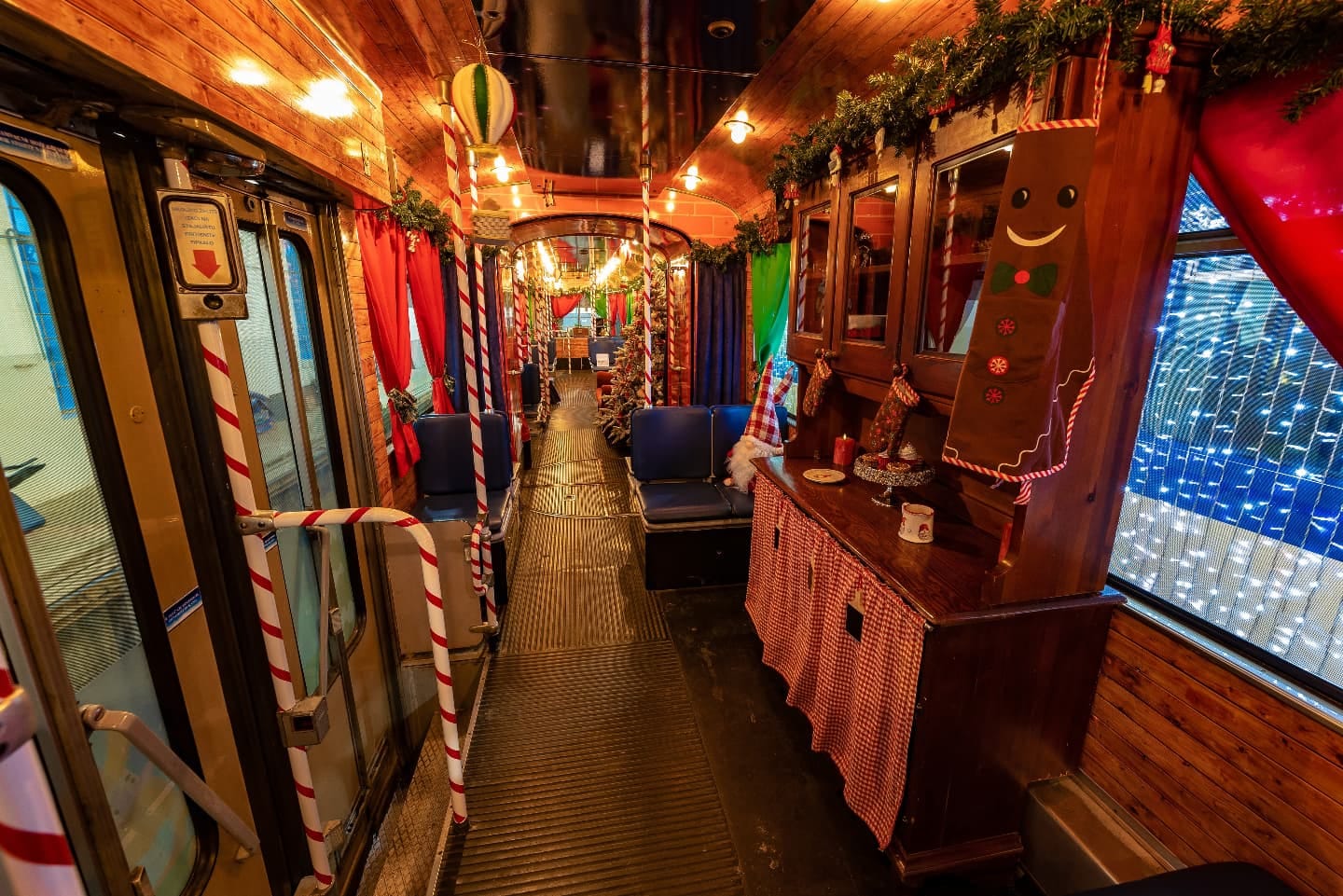
Photo: Osijek Tourist Board/Facebook
The size of a city is not defined by the number of kilometers or the number of inhabitants but is measured by the size of the heart, the strength of the spirit, the kindness of the people. Osijek has long been said to be a "city made to measure" and is big enough to fulfill your needs, desires, dreams and small enough to feel safe, comfortable, and intimate. Big enough to organize the longest walk around the city, small enough to adapt the concept of the Advent celebration to the current situation in a short time.
The senses conceived their Advent through the concept "it is not standing but moving, and it is not a place but a journey". Advent, conceived as a movement around holiday-decorated locations, revived Osijek, showed the character and spirit of Osijek, and revived memories of other times when daily walks and full streets were the main motives for good fun in Osijek for all generations.
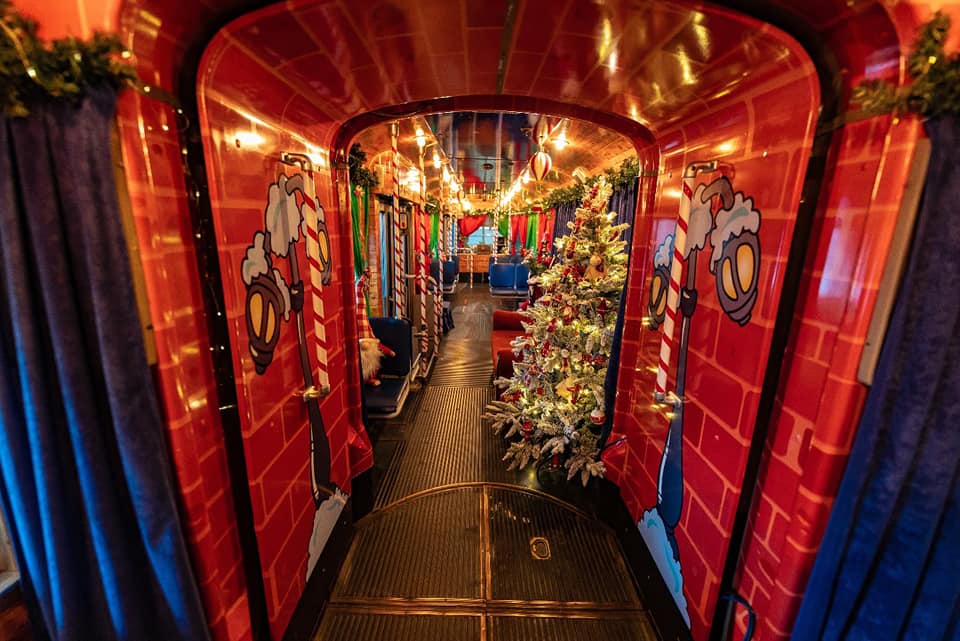
Photo: Osijek Tourist Board/Facebook
And the only real success of Advent is happy and smiling people. Positive emotions, sparkle in the eyes, gratitude, togetherness, which is not lacking in the Slavonian metropolis, which lives 354 days a year with full lungs.
If you want to learn more about the breathtaking capital of Slavonia, be sure to check Total Croatia's Osijek in a Page here.
For more on travel in Croatia, follow TCN's dedicated page.



